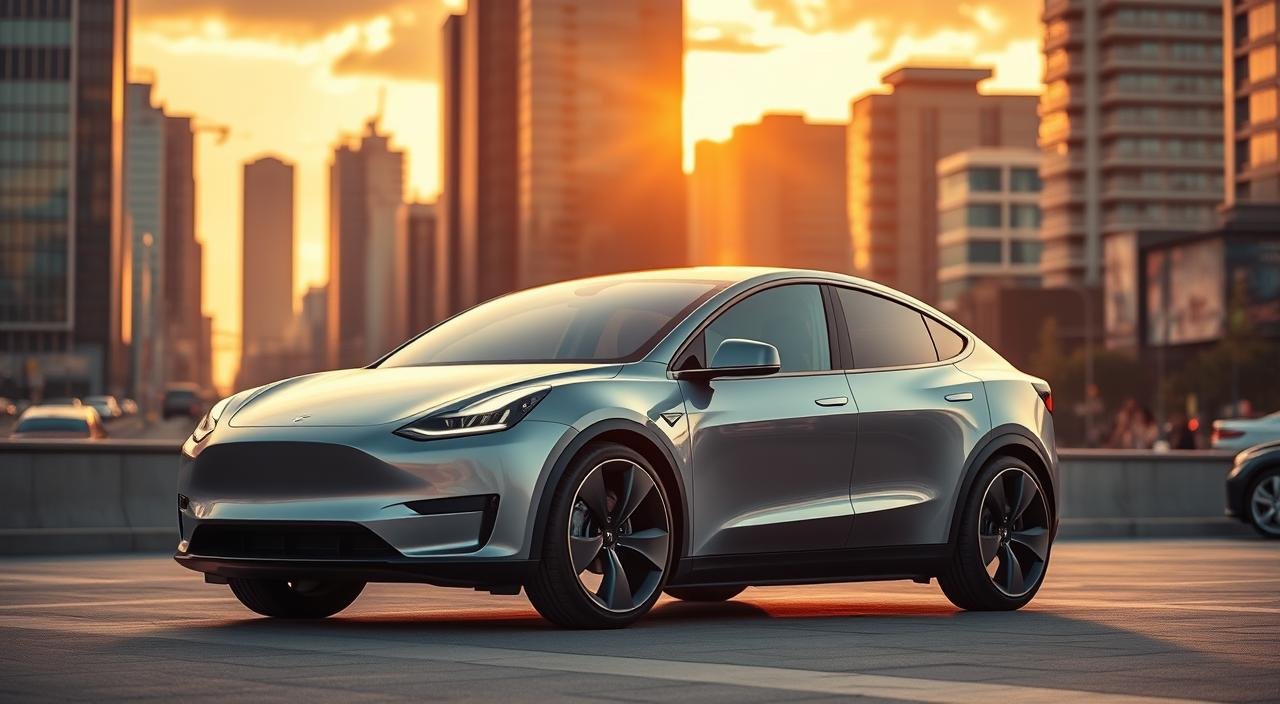
Oct
Electric vehicles in India have seen a huge jump of 112% in 2024. Over 1.5 million units were sold across the country. This growth is setting the stage for Tesla’s latest move in India.
The Tesla Model Y has received a big upgrade. The Long Range variant now goes 661 km on a single charge. This is a 39-kilometer increase from before. And the best part? The price remains the same, at Rs 67.89 lakh for the Long Range RWD variant.
Tesla made this upgrade in October 2025. This was just a month after starting deliveries in India. The new battery pack is 84.2 kWh, made by LG. It replaces the older 78.1 kWh battery system.
The Tesla Model Y now offers 661 km range in India. And it keeps its original price of Rs 59.89 lakh for the Standard RWD variant. This makes the Tesla Model Y even more appealing to Indian buyers. It’s now one of the longest-range electric SUVs in India.
Key Takeaways
- Tesla Model Y Long Range variant now delivers 661 km WLTP-certified range in India
- The upgrade adds 39 km to the previous 622 km range without any price increase
- New 84.2 kWh battery pack with LG high-density cells powers the enhanced range
- Prices remain at Rs 59.89 lakh for Standard RWD and Rs 67.89 lakh for Long Range RWD
- The quiet update happened in October 2025, one month after India deliveries began
- Tesla Model Y becomes one of the longest-range electric SUVs in the Indian market
Introduction to Tesla Model Y in India
The electric SUV market in India got a big boost when Tesla launched the Model Y in July 2025. This was a key moment for Tesla’s entry into India, a rapidly growing market. Tesla now has showrooms in Mumbai and Delhi, making its advanced electric vehicles available to Indian buyers.
Overview of Tesla’s Impact on Indian Market
When Tesla arrived in India, it sparked a lot of excitement. Over 600 people booked the Model Y soon after it was launched. In September, Tesla delivered more than 60 cars, showing a strong demand for electric vehicles in India.
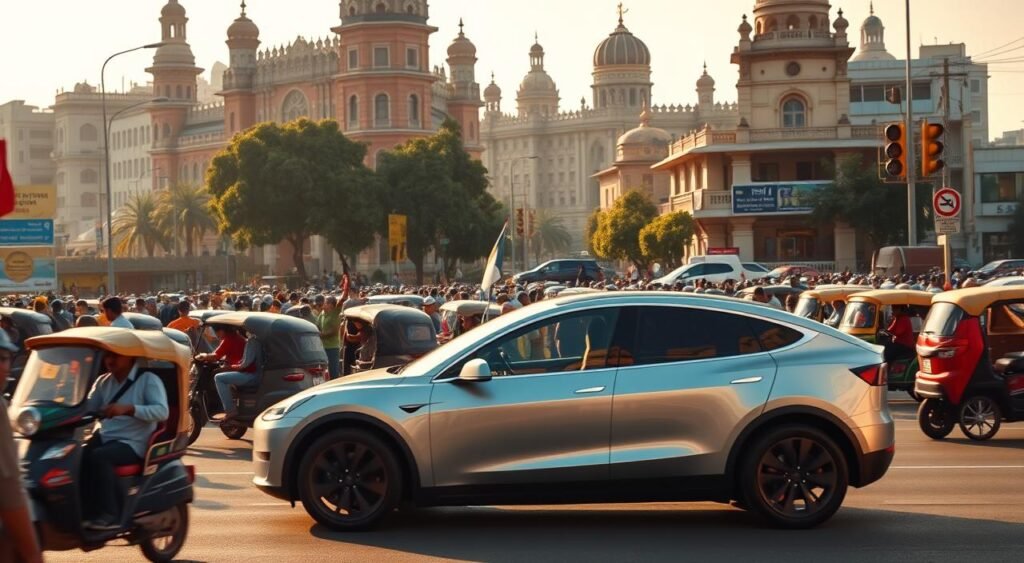
The Model Y comes in two versions for Indian roads. The Standard Range RWD has a 500 km range. The Long Range RWD can go up to 661 km on one charge.
Key Specifications of Tesla Model Y
The Model Y stands out in India’s electric SUV market with its impressive specs:
- Acceleration: 0-100 km/h in 5.6 seconds (Long Range) or 5.9 seconds (Standard)
- Top Speed: 201 km/h for both variants
- Charging Capability: 250 kW fast charging (Long Range) and 175 kW (Standard)
- Range Options: 500 km or 661 km depending on variant
The 661 km Range: What It Means for Indian Consumers
The Tesla Model Y’s 661 km range changes how Indian drivers see Electric Vehicles. It tackles the main worry people have when thinking about electric cars. Now, families can easily go from Mumbai to Pune and back without needing to charge again.
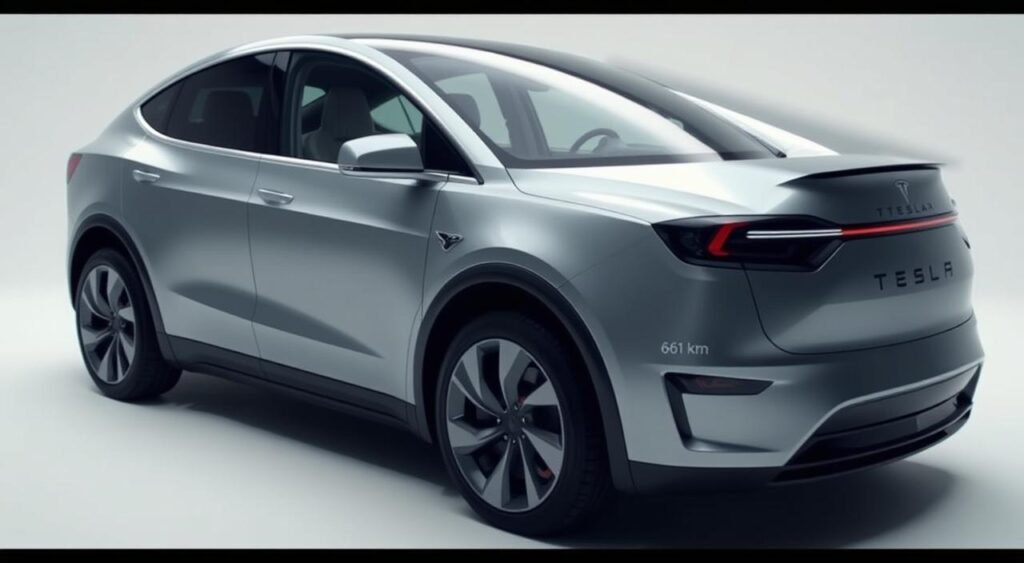
Benefits of an Extended Range
The 661 km Range makes electric cars less intimidating. People in cities like Delhi or Bangalore can drive for a whole week without needing to charge. The Long Range model can charge up to 267 kilometers in just 15 minutes, great for quick stops.
This range is ideal for India’s varied driving conditions. Whether in city traffic or on highways, the Model Y performs well. Its rear-axle electric motor provides smooth acceleration and high efficiency.
Comparison with Other Electric Vehicles
| Model | Range (km) | Fast Charging Speed |
|---|---|---|
| Tesla Model Y | 661 | 250 kW |
| BMW iX1 | 440 | 130 kW |
| Volvo EX30 | 480 | 153 kW |
| Mercedes EQB | 423 | 100 kW |
The Model Y stands out in India’s premium electric car market. Its long range and fast charging make it the top choice for those needing reliable long-distance travel.
Pricing Structure of the Tesla Model Y in India
The Tesla Model Y offers great value in India with its current prices. It comes in two variants, meeting different customer needs. Tesla aims to make luxury electric cars affordable for Indian buyers.
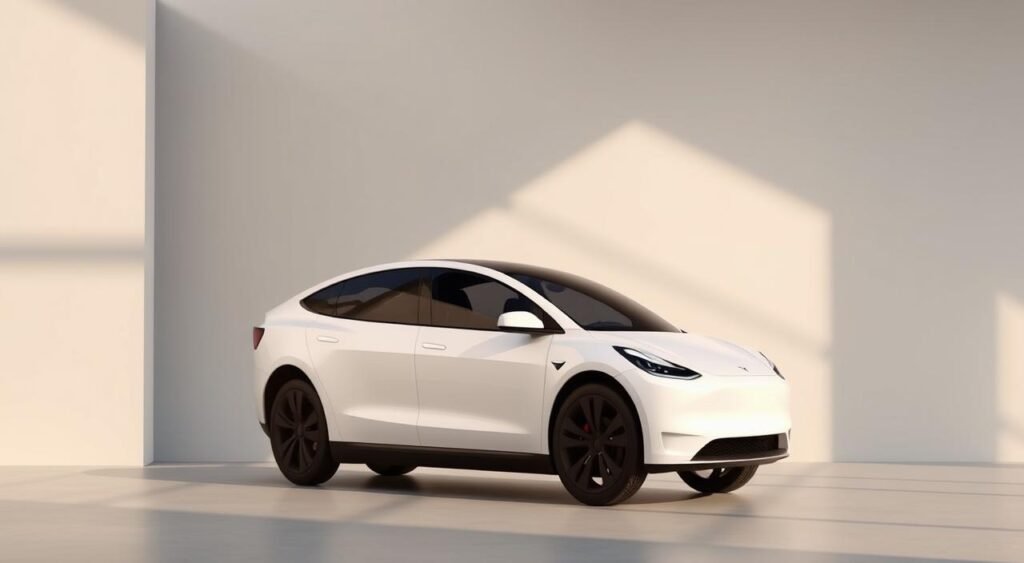
Breakdown of Costs and Financing Options
The Tesla Model Y starts at Rs 59.89 lakh for the Standard Range Rear-Wheel Drive. The Long Range RWD version costs Rs 67.89 lakh ex-showroom. In New Delhi, the base variant’s on-road price is about Rs 68.85 lakh.
| Variant | Ex-showroom Price | Battery Capacity |
|---|---|---|
| Standard Range RWD | Rs 59.89 lakh | 84.2 kWh |
| Long Range RWD | Rs 67.89 lakh | 84.2 kWh |
| Full Self-Driving Add-on | Rs 6 lakh extra | N/A |
Why the Price Remains Competitive
Tesla has upgraded the battery to 84.2 kWh without raising the Model Y’s price in India. This move helps Tesla stay competitive in the premium EV market. Tesla also offers online booking and doorstep delivery, saving on dealership costs.
Features and Specifications of the Tesla Model Y
The Tesla Model Y is a top choice in the Electric SUV market in India. It combines advanced technology with luxury comfort. This makes it a standout in the industry.
Interior and Comfort
Inside the Tesla Model Y, you’ll find a modern and spacious cabin. The 15.4-inch front touchscreen controls most of the car’s functions. Rear passengers get their own 8-inch screen for entertainment and climate control.
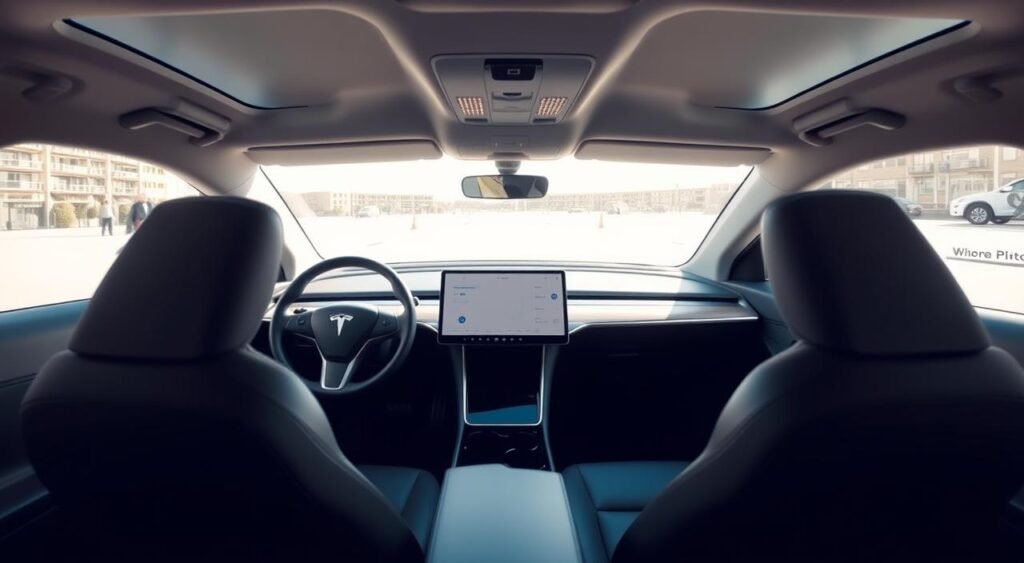
The car focuses on comfort with features like ventilated and heated front seats. The rear seats offer heating and power-folding for more space. A panoramic glass roof adds natural light, making every drive feel open.
There are five USB Type-C ports, each providing 65W output. This keeps your devices charged on long trips across India.
Safety Features and Ratings
Safety is a key part of the Tesla Model Y’s design. It has earned top safety ratings worldwide. This is thanks to its advanced protection systems.
| Safety Feature | Description |
|---|---|
| Autopilot System | Eight cameras provide 360-degree visibility |
| Airbag Protection | Front, side, and curtain airbags throughout cabin |
| Collision Avoidance | Automatic emergency braking and blind spot monitoring |
| Structural Design | Reinforced battery architecture for impact protection |
The Technology Behind the Tesla Model Y
The Tesla Model Y is a big step forward in electric cars for India. It has advanced battery systems and fast charging. This makes it a great choice for those who want long drives without losing speed.
Battery Technology and Charging Infrastructure
The Long Range model has an 84.2 kWh battery pack. It’s made by LG and is very efficient. This helps it go up to 661 km on a single charge.
The Standard model has a 60-64 kWh battery pack. It’s perfect for daily trips.
Tesla made the Model Y to work well with many charging options in India. It can charge up to 250 kW at Tesla Superchargers and other places. This means you can quickly add a lot of range during short stops.
Performance and Efficiency
The Long Range Model Y has a 299-horsepower electric motor. It goes from 0 to 100 km/h in just 5.6 seconds. This shows how electric cars can be both fast and efficient.
The car’s energy management system helps it use power wisely. It adjusts the motor and regenerative braking for better range and quick acceleration when you need it.
Environmental Impact of the Tesla Model Y
The Tesla Model Y is a key player in making India’s cars greener. It has no tailpipe emissions, which helps clean the air in cities like Delhi and Mumbai. These cities often have too much pollution. The Model Y also supports a wider goal of making transportation more sustainable.
How Electric Vehicles Contribute to Sustainability
Electric cars like the Tesla Model Y are changing how we think about cars. They don’t emit carbon dioxide when you drive them, which is great for crowded cities. EVs are 60% cleaner than gas cars, even when you consider how the electricity is made.
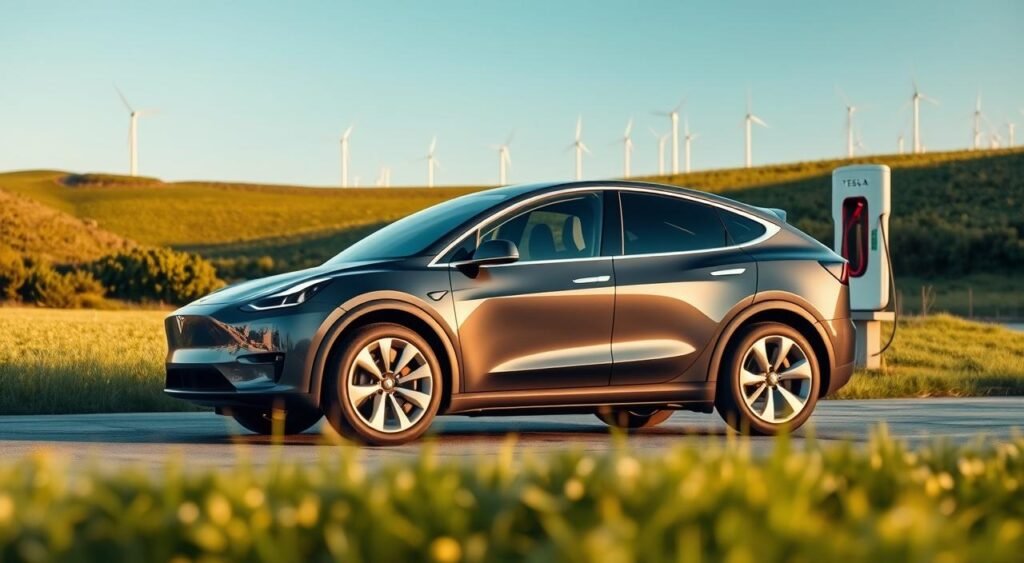
The Model Y now has a bigger battery pack. It can go 661 kilometers on one charge. This means you need to charge it less often, which saves energy for everyone in India.
| Environmental Metric | Tesla Model Y | Conventional SUV |
|---|---|---|
| Annual CO2 Emissions | 0 kg (direct) | 4,600 kg |
| Air Pollutants | Zero tailpipe | NOx, PM2.5, CO |
| Energy Efficiency | 120 MPGe | 25 MPG |
Tesla’s Commitment to Green Energy
Tesla is all about being green, from making cars to making energy. Their factories use more and more clean energy. In India, Tesla wants to work with green energy companies to make sure charging stations use clean power.
Customer Reviews and Feedback
Early adopters in India have shared their thoughts on the Tesla Model Y. This has given valuable insights to those thinking of buying it. With over 600 bookings and 60 deliveries in September 2025, feedback shows both excitement and practical thoughts on its performance in India.
User Experiences with Range and Performance
The Tesla Model Y now has a 661 km range in India. This has impressed early owners who travel a lot between cities. They say the long range makes long trips on Indian highways worry-free.
Drivers also love how fast it goes from 0-100 km/h and its top speed of 201 km/h. They say it’s a big improvement from traditional luxury sedans.
Performance consistency is a big plus in reviews. Owners like that both variants drive the same, so there’s no difference in the driving experience.
Common Concerns from Indian Buyers
Price is a big worry for many in India. The Long Range variant costs Rs 67.89 lakh. Buyers wonder if it’s worth it for their first luxury electric vehicle.
Some concerns include:
- Charging infrastructure availability in tier-2 cities
- Service center accessibility across different states
- Battery performance during extreme Indian summer temperatures
- Resale value in the developing EV market
Despite these worries, the improved EV range has helped address previous concerns. It makes electric vehicles more appealing for Indian roads.
The Future of Electric Vehicles in India
India’s electric vehicle market is at a turning point. Tesla’s entry through Mumbai and Delhi showrooms shows strong growth. The Model Y’s 600+ bookings show Indian buyers are eager for premium Electric Vehicles.
This move is more than just luxury car sales. It’s a big change in India’s transportation and sustainability.
Government Policies and Incentives
The Indian government is pushing for more EVs. State governments don’t charge registration fees or road taxes for electric cars. The FAME II scheme gives subsidies from ₹10,000 to ₹1.5 lakh, based on battery size.
India aims to put charging stations every 25 kilometers on highways. This will help with range anxiety.
Predictions for EV Adoption Rates
Experts say India’s EV sector will grow a lot in the next decade. Better infrastructure and lower prices make Electric Vehicles more appealing to buyers.
| Year | Projected EV Sales | Market Share | Charging Stations |
|---|---|---|---|
| 2024 | 1.5 million | 8% | 12,000 |
| 2026 | 3.2 million | 15% | 25,000 |
| 2030 | 10 million | 30% | 80,000 |
Tesla’s 661 km range shows Electric Vehicles can be practical in India. As battery tech gets better and costs drop, more people will be able to buy them.
Comparison with Tesla’s Competitors
The Tesla Model Y is up against tough competition in India’s luxury electric SUV market. Many top brands have entered the market with their electric cars. They all aim to win over buyers who care about the environment.
The fight is about who can offer the longest range, fastest charging, and the best price. This is what Indian consumers look for.
Key Players in the Indian EV Market
India’s luxury electric SUV market has some big names. The BMW iX1 shows off German engineering with a range of about 440 kilometers. Volvo’s EX30 appeals to those who love eco-friendly cars with Scandinavian style and a 480-kilometer range.
Mercedes-Benz has the EQB, which offers three rows of seats and a range of about 420 kilometers. Each brand has its own strengths.
BMW is all about driving fun, Volvo focuses on safety, and Mercedes-Benz is known for luxury. Prices range from Rs 66 lakhs to Rs 77 lakhs for these models.
Differentiating Factors of the Tesla Model Y
The Tesla Model Y has a standout feature: its range of 661 kilometers. This beats all its competitors in the luxury electric SUV market. It can charge up to 267 kilometers in just 15 minutes, thanks to its 250 kW fast charging.
Tesla’s global tech system is another big plus. The Full Self-Driving option, available for Rs 6 lakh extra, offers advanced autonomous tech. The price hasn’t changed even with battery upgrades, making the Tesla Model Y a great deal for luxury electric car buyers.
Conclusion: Is the Tesla Model Y Worth It for Indian Consumers?
The Tesla Model Y now offers 661 km range in India at Rs 67.89 lakh for the Long Range variant. This shows Tesla gets what the Indian market wants. The extended range tackles a major worry for EV buyers in India – running out of charge on long trips.
With 250 kW fast charging and premium features, the Model Y is a top choice in luxury EVs. It’s both practical and luxurious.
Final Thoughts on Value for Money
Tesla kept the price the same but upgraded the battery. This makes the Model Y more appealing to Indian buyers. The 661 km range is better than most electric vehicles in India today.
Premium features like autopilot and over-the-air updates add value. The minimalist interior also justifies the price. For those looking for a luxury EV that works in real life, the Model Y is a great choice.
The Future of Tesla in India
So far, the market response is positive with over 600 bookings. Tesla keeps improving its products without raising prices. This strategy could help Tesla grow in India’s premium EV market.
The 661 km range upgrade is perfect for Indian driving and long trips. As charging infrastructure grows, Tesla is ready to take advantage of the electric shift.
FAQ
What is the new WLTP-certified range of the Tesla Model Y Long Range in India?
The Tesla Model Y Long Range now has a 661 km WLTP-certified range in India. This is 39 km more than the previous 622 km claim. The upgrade comes from a new 84.2 kWh battery pack with LG-made high-density cells, replacing the older 78.1 kWh/79 kWh pack.
How much does the Tesla Model Y cost in India after the range upgrade?
Despite the big battery upgrade, prices stay the same. The Standard RWD variant costs Rs 59.89 lakh, and the Long Range RWD variant costs Rs 67.89 lakh (ex-showroom). In New Delhi, the Long Range model costs about Rs 68.85 lakh on the road.
What are the charging capabilities of the Tesla Model Y Long Range?
The Long Range variant can charge up to 267 km in 15 minutes with 250 kW fast charging. The Standard variant charges at 175 kW. Both can use Tesla Superchargers and third-party charging points in India.
How does the Tesla Model Y compare to other Electric SUVs in India?
The Model Y’s 661 km range is better than competitors like the BMW iX1, Volvo EX30, and Mercedes EQB. Its fast charging and range make it a top choice in the Indian market.
What are the performance specifications of the Tesla Model Y variants?
The Long Range variant goes from 0-100 km/h in 5.6 seconds. The Standard variant takes 5.9 seconds. Both have a top speed of 201 km/h. The Long Range has a 299hp rear-axle-mounted electric motor.
What is the Full Self-Driving (FSD) package, and how much does it cost?
Tesla’s Full Self-Driving package costs Rs 6 lakh extra. It offers advanced autopilot features. But, full autonomous driving may need regulatory approval in India.
How has the market responded to Tesla’s entry into India?
The Tesla Model Y has been well-received, with over 600 bookings and 60 deliveries in September 2025. This shows strong interest in premium Electric Vehicles in India.
What are the key interior features of the Tesla Model Y?
The Model Y has a 15.4-inch front touchscreen and an 8-inch rear touchscreen. It has ventilated, heated, and power-adjustable front seats. It also has heated rear seats, a panoramic glass roof, and 19-inch Crossflow alloy wheels.
How does the Tesla Model Y contribute to Sustainability?
The Model Y’s electric drivetrain produces no tailpipe emissions, reducing air pollution in Indian cities. The new battery pack and Tesla’s renewable energy efforts support sustainable transport in India.
Where can Indian customers purchase and service the Tesla Model Y?
Tesla opened showrooms in Mumbai and Delhi in July 2025. Customers can book online and get doorstep deliveries, making it easy for luxury buyers across India.
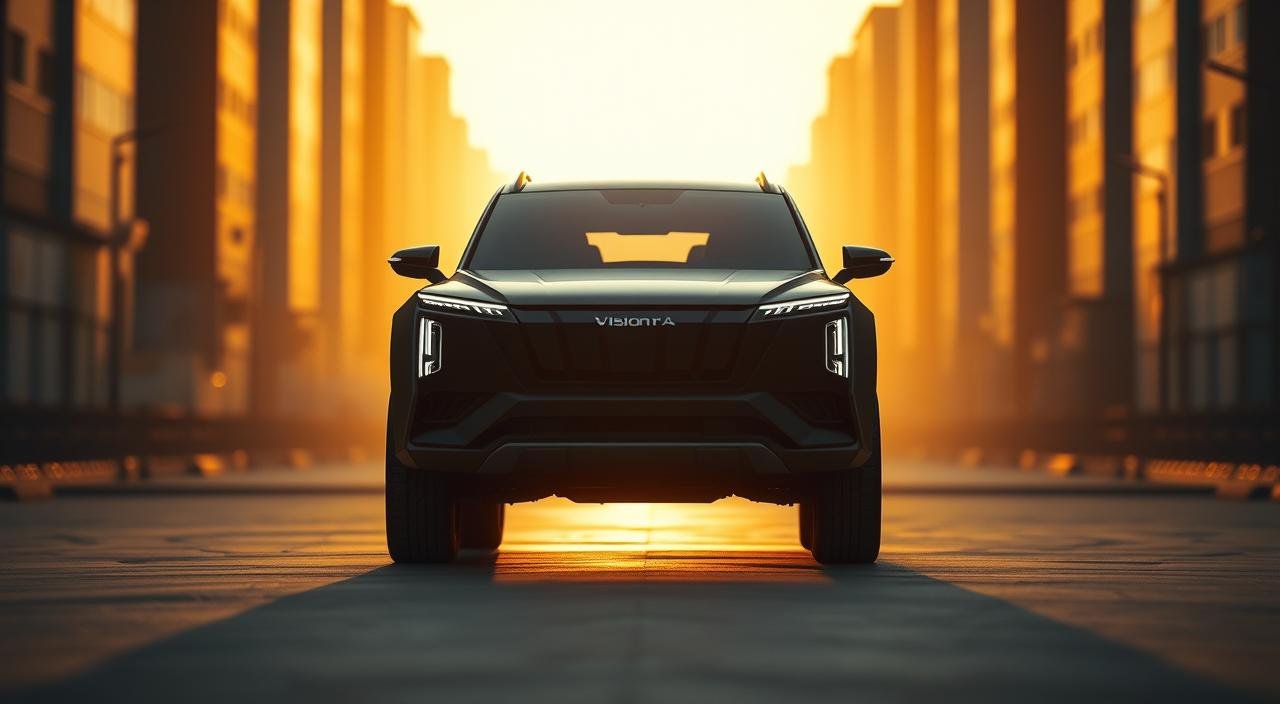
Aug
Did you know Mahindra unveiled an electric SUV concept that could change India’s off-road market? The Mahindra Vision T Concept debuted on India’s 79th Independence Day. It brings excitement to electric vehicles with its rugged design and advanced tech.
The Vision T Concept is an electric version of Mahindra’s beloved Thar. It has unique design features that make it stand out. Built on the NU IQ platform, it has six exclamation mark-shaped grille slats and LED pixel DRLs. It also has strong bumpers with bright yellow tow hooks.
Many car fans saw this groundbreaking vehicle. But, there are key details about the Mahindra Vision T Concept that are not well-known. It has a flexible design that supports both front-wheel and all-wheel drive. It also has the chance to be sold in international markets with left and right-hand drive options.
Key Takeaways
- The Mahindra Vision T Concept debuts as an electric version of the popular Thar off-roader
- Features innovative design elements including six exclamation-shaped grille slats and LED pixel DRLs
- Built on the flexible NU IQ platform supporting multiple powertrain configurations
- Offers both FWD and AWD options with the chance for global market expansion
- Maintains the iconic boxy silhouette while incorporating modern electric vehicle technology
- Showcases Mahindra’s commitment to developing versatile platforms for future vehicles
A Brief Overview of the Mahindra Vision T Concept
The Mahindra Vision T Concept is a big step for the Indian car maker towards electric cars. It was shown at the Mahindra auto show with three other concepts. This tough SUV shows Mahindra’s big plans for the future of cars.
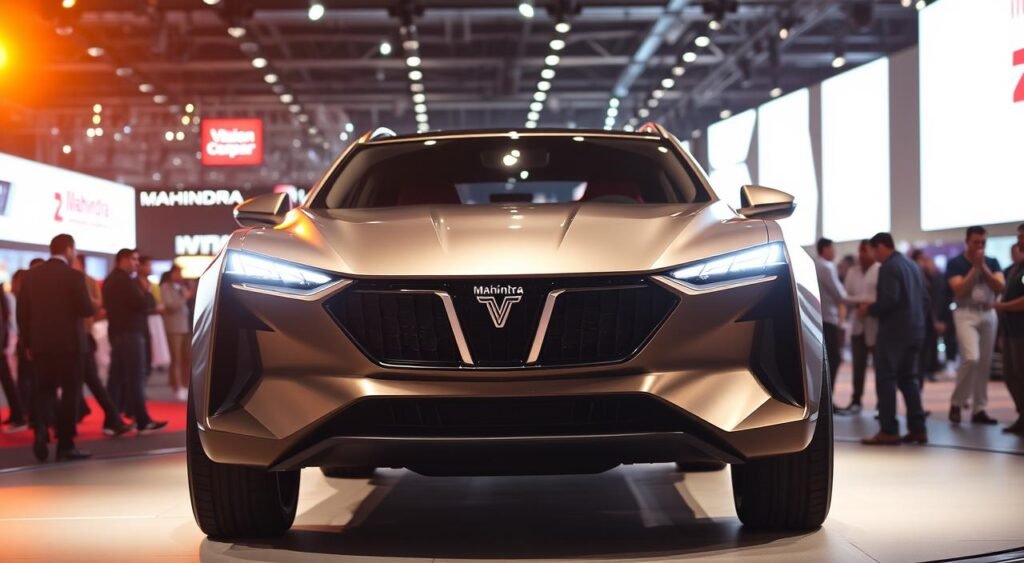
Introduction to the Mahindra Vision T
The Vision T Concept is based on the popular Thar lineup but is electric. It has cool design features that keep its off-road spirit alive. It has big wheel arches, exposed door hinges, and strong tires for off-road adventures.
Key design features include:
- Tailgate-mounted spare wheel with dual-tone alloy designs
- Chunky all-terrain tires for superior grip
- Rugged exterior styling with modern touches
- Evolution of the Thar E concept shown in South Africa in 2023
Significance in Mahindra’s EV Strategy
The Vision T is key in Mahindra’s plan for electric cars. It will be made between late 2027 and early 2028. This shows Mahindra’s goal to make all its cars electric, even the tough off-road ones.
By making an electric version of its famous off-road car, Mahindra shows that green cars can be adventurous too. The Vision T Concept connects eco-friendly driving with the thrill of off-road adventures.
Innovative Design Features of the Vision T
The Mahindra future car, the Vision T Concept, is a bold step forward. It combines rugged capability with modern styling. This design appeals to young buyers who want adventure and modern comforts.
The concept shows Mahindra’s commitment to evolving their design. They keep the essence that makes their vehicles stand out.
Exterior Aesthetics and Functionality
The Vision T Concept’s exterior is a perfect mix of looks and practicality. Its front has striking LED headlamps and integrated DRLs for a unique light. The chunky bumper has fog lamps and exposed bonnet latches for a rugged look.
The side profile keeps the classic boxy shape off-road fans love. It has:
- Squared-off wheel arches for better ground clearance
- Blacked-out ORVMs for a sporty look
- Dual-toned alloy wheels for style and durability
- Exposed door hinges for utility
- Jerry can behind the C-pillar for longer trips
The rear has vertical tail lamps that match the DRL pattern. A strong bumper with a silver skid plate shows its off-road strength.
Interior Layout and Technology Integration
Inside, technology is key without overwhelming the driver. The cabin has a large touchscreen display for controlling the car. A curved driver’s display shows important info, and the 3-spoke steering wheel is comfortable for any drive.
| Interior Feature | Description | Benefit |
|---|---|---|
| Portrait Touchscreen | Large vertical display | Enhanced visibility and control |
| Curved Driver Display | Floating digital cluster | Improved ergonomics |
| Physical Controls | Tactile buttons return | Easier operation off-road |
| Dark Theme Interior | Premium materials | Sophisticated ambiance |
The Vision T Concept shows a return to physical button controls. This is because tactile feedback is key for driver confidence. The dark theme interior adds sophistication and is practical for those who value durability and easy maintenance.
Advanced Technology: What to Expect
The Mahindra electric vehicle is packed with the latest tech. It uses the NU IQ platform, which is super flexible. This platform supports electric, hybrid, and traditional powertrains.
It can fit different body styles and drivetrain layouts. This makes it great for both front-wheel and all-wheel drive setups.
AI and Connectivity Innovations
The Vision T Concept has a big portrait display system. It’s the heart of connectivity, showing navigation, entertainment, and vehicle controls. Mahindra balances digital innovation with practical physical buttons.
This ensures drivers can access important functions easily. It keeps them focused on the road.
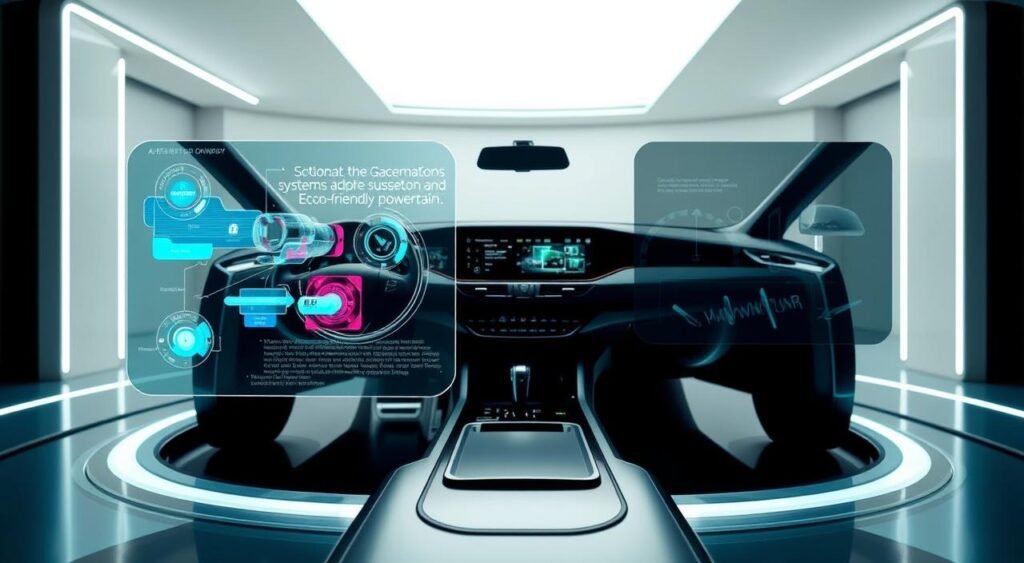
- Smartphone integration for seamless device pairing
- Real-time traffic updates and route optimization
- Over-the-air software updates for continuous improvement
- Voice command systems for hands-free operation
Safety Features and Enhancements
The NU IQ platform brings advanced driver assistance systems to the Vision T Concept. These safety technologies protect occupants in city driving and off-road adventures. The platform’s design supports enhanced visibility and collision prevention.
The Mahindra electric vehicle has sensors all over to watch the surroundings. These systems alert drivers to hazards and can act to prevent accidents. The platform works well for both left-hand and right-hand drive without losing safety.
Sustainable Practices Behind the Mahindra Vision T
The Mahindra Vision T shows the company’s dedication to the environment. It combines new sustainable tech with the brand’s rugged look. Built on the IQ platform, it proves electric cars can be tough and green.
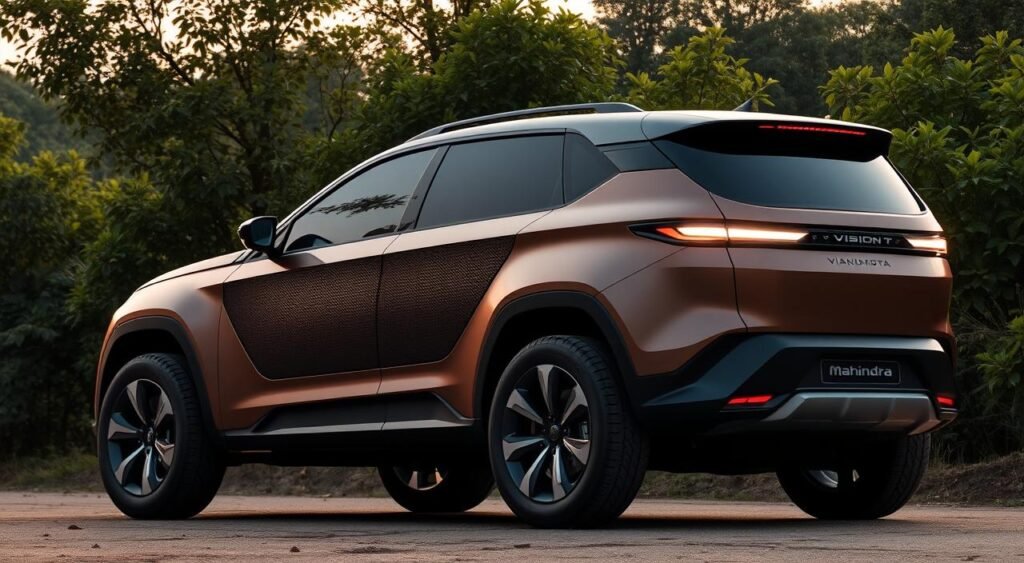
Eco-Friendly Materials Used
The Vision T uses recycled plastics and bio-based materials inside. Its seats are made from ocean waste, and the trim is bamboo. These choices cut down on carbon emissions without losing comfort or strength.
The battery casing is made from 95% recyclable aluminum. Even the floor mats are from recycled rubber. This shows Mahindra’s focus on green details in every part.
Energy Efficiency and Performance Goals
The IQ platform helps the Vision T meet high efficiency goals. It supports different powertrain options:
- Pure electric setup with over 400 kilometer range
- Hybrid for longer trips
- Regenerative braking to save up to 30% energy
Plans to start production in late 2027 match India’s EV goals. The Vision T’s creation shows Mahindra’s plan to make electric cars for all, keeping performance high.
Market Positioning of the Mahindra Vision T
The Mahindra Vision T Concept is a game-changer in India’s electric vehicle scene. It’s an off-road electric SUV that stands out from the usual city-focused EVs. At the Mahindra auto show, it showed how it can handle both rough outdoor adventures and city driving.
Target Demographics in India
The Vision T is designed for India’s young people, with a bold, Gen-Z-inspired look. It targets young professionals aged 25-35 who love adventure and city life. It keeps the legendary Thar brand’s tough vibe but adds modern electric tech.
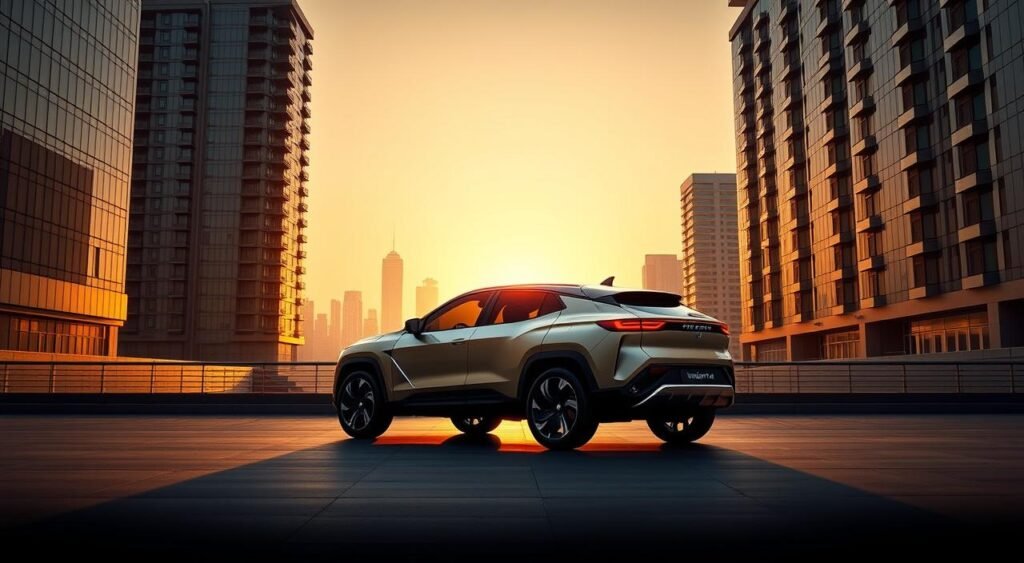
Urban millennials who care about the planet and performance are also key buyers. They want an EV that shows they’re eco-friendly and love adventure. The Vision T’s tech features, like advanced connectivity and AI, are perfect for India’s tech-loving youth.
Competitive Analysis with Other EVs
The Vision T is a pioneer in the electric off-roader market in India. Unlike others, it’s made for both city and off-road use. Its NU IQ platform allows it to be driven on either side, setting it up for global markets.
Future Vision: Mahindra’s Longer-Term Goals
Mahindra has big plans for electric vehicles in India. They aim to change the car market with a clear plan. They will launch many models in the next five years, each for a different market segment.
Expansion Plans in the EV Market
The first step is the Vision S in early 2027. It will enter the premium Mahindra electric vehicle market. Later in 2027, the Vision T and Vision SXT will join the lineup, adding more variety.
The Vision SXT is a pickup truck with a unique design. It has twin spare wheels and a bold black-and-orange interior.
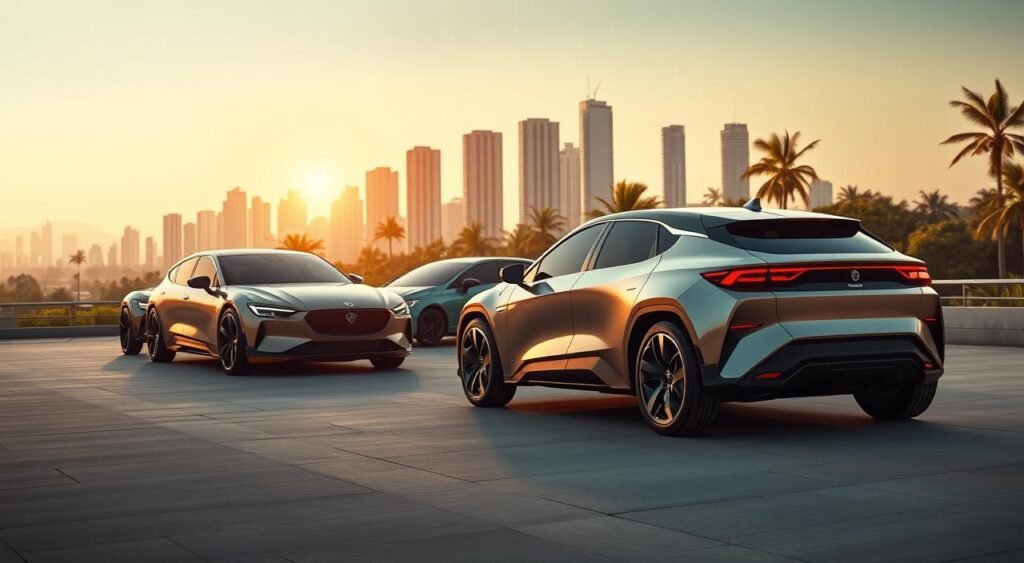
By mid-2028 to early 2029, the Vision X will arrive. It’s aimed at the compact SUV market. This shows Mahindra’s dedication to electric options at various price points.
Upcoming Models and Concepts in Development
Each Mahindra Concept car brings new features to different markets. The Vision X concept has LED headlights and a closed-off grille. It also has 19-inch alloy wheels and NFC door access for easy entry.
All new models will use the NU IQ platform. This platform supports different powertrains. It helps Mahindra develop cars faster and more affordably, without sacrificing quality.
Customer Reactions and Industry Buzz
The Vision T Concept was the star at the Mahindra auto show. It caught the eye of fans and experts. This electric off-roader talked about the future of India’s Thar lineup, mixing tradition with new tech.
Initial Impressions from the Auto Expo
People at the Independence Day showcase were really excited. They loved the Vision T Concept’s look. It took the classic Thar design and made it modern but kept it familiar.
What really drew people in was:
- Rugged exterior styling with modern electric vehicle touches
- A tech-savvy interior with a big portrait display
- A design that’s young and adventurous
- It kept the off-road skills but went green
Media Coverage and Expert Opinions
Car journalists loved how Mahindra showed off electric vehicles. The Vision T Concept was a hit for making the Thar name bigger. It could win over young people who want green adventure cars.
Experts said it’s part of Mahindra’s big EV plan. They talked about the feature-rich interior and bold exterior design. They think it could do well in India’s changing car market.
Conclusion: The Future of Mahindra in the EV Space
The Vision T concept is a big step for Mahindra’s electric car plans. It shows the company’s commitment to making electric cars for all. They aim to start making these cars by late 2027 or early 2028.
Implications for Electric Vehicle Adoption in India
The Vision T could change how people in India see electric off-road cars. It’s built on a flexible platform that can meet various needs. This comes at a time when more Indians care about the environment.
Electric versions of popular SUVs might make people choose cleaner cars over gas ones.
Final Thoughts on the Vision T Concept
After launching the BE 6 and XEV 9e, the Vision T shows Mahindra’s full electric plan. It’s a car that combines old-school ruggedness with new tech. This electric off-roader is ready for city driving and tough trails.
The Vision T shows electric cars can do it all, from city streets to rough terrains.
FAQ
When will the Mahindra Vision T Concept enter production?
The Mahindra Vision T is set to hit the market between late 2027 and early 2028. This follows the Vision S, which is expected in early 2027. It’s a key part of Mahindra’s electric vehicle plans.
What platform is the Vision T built on?
The Vision T uses Mahindra’s new NU IQ platform. This platform is very flexible. It supports different powertrains like ICE, EV, and hybrid. It also works for FWD and AWD, and can be made for left-hand and right-hand drive for global markets.
Is the Vision T related to the Mahindra Thar?
Yes, the Vision T is an electric version of the Thar. It keeps the Thar’s boxy look but adds modern touches. It’s an updated version of the Thar E concept from 2023.
What are the key design features of the Mahindra electric vehicle?
The Vision T has a cool front with six rectangular slats and LED DRLs. It also has chunky bumpers and yellow tow hooks. The design includes squared-off wheel arches and all-terrain tires. It even has a tailgate-mounted spare wheel.
How does the Vision T fit into Mahindra’s broader EV strategy?
The Vision T is part of Mahindra’s four-concept showcase. It joins the Vision S, Vision X, and Vision SXT. It’s a key part of Mahindra’s electric vehicle strategy, aiming for a unique spot in the market.
What technology features can we expect in the Vision T’s interior?
The Vision T’s interior is packed with tech. It has a large touchscreen display and a 3-spoke steering wheel. The cabin will have a dark theme, blending tech with practicality.
Will the Vision T be available only as an electric vehicle?
The Vision T is shown as an electric concept. But its NU IQ platform can handle different powertrains. This means Mahindra might offer various options to meet market needs.
What was the public reaction to the Vision T at the Mahindra auto show?
The Vision T got a lot of buzz at the Independence Day showcase. People loved how it updated the Thar’s design. It was seen as a hit with Gen-Z, blending ruggedness with modern style.
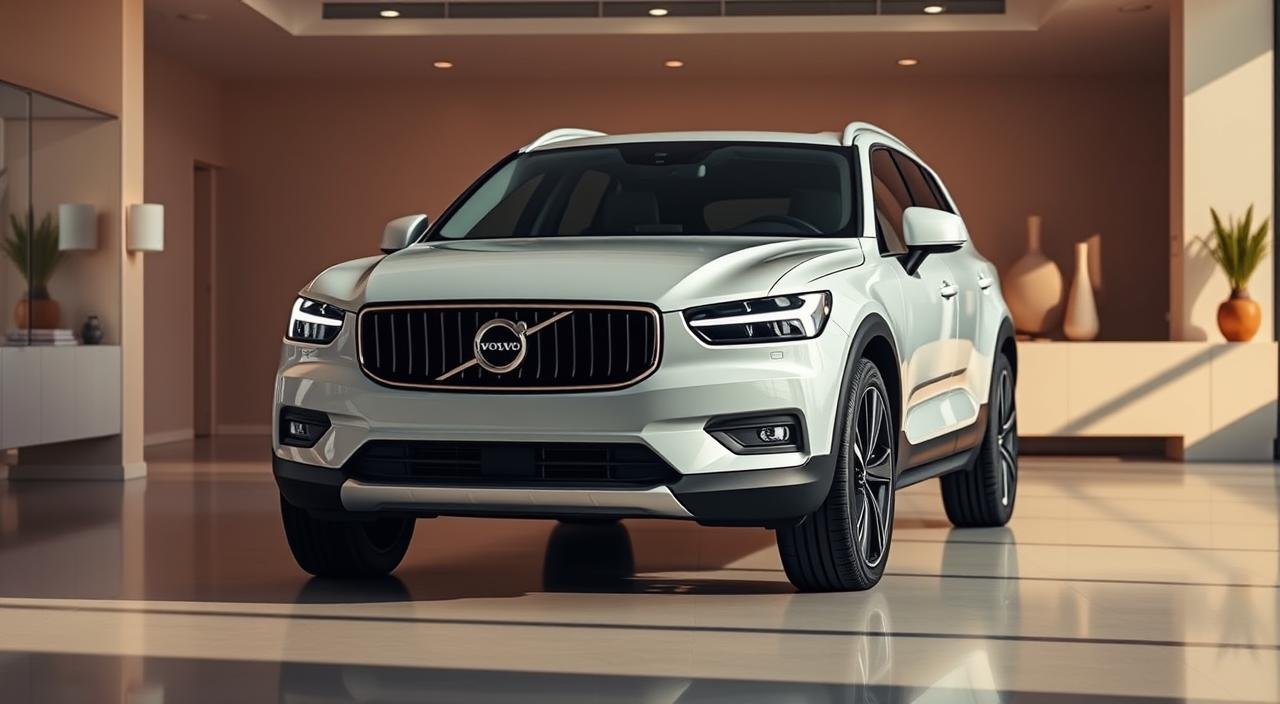
Aug
Can a compact electric SUV from Volvo really deliver the same premium experience as its larger siblings while being wallet-friendly? The answer might surprise you when it comes to the Volvo EX30 Electric SUV review.
The Volvo EX30 marks a bold new chapter for the Swedish automaker in India. It’s not another massive luxury cruiser like the XC90 or the refined XC60. Instead, Volvo has created a compact electric SUV that fits perfectly into urban environments.
At just 4.2 meters long, the EX30 packs surprising capability into a footprint similar to a large hatchback. The car carries all the familiar Volvo DNA while adding fresh, youthful character. This sets it apart from its siblings. Despite being called Volvo’s “baby,” this electric SUV proves that good things come in small packages.
The EX30’s journey to India tells an interesting story. Designed in Sweden and developed in China – the world’s largest electric vehicle producer – it will be assembled in Bangalore. This global collaboration has already earned recognition, with the EX30 winning the 2023 BBC Top Gear Eco Warrior of the Year award in the UK.
Set to launch in September, the EX30 will compete directly with the Mini Cooper SE in the premium compact electric segment. With expected pricing between Rs 35-40 lakh thanks to local CKD assembly, it promises to make Volvo’s electric technology more accessible. Built on a dedicated electric platform shared with the Smart #1 and Zeekr X, the EX30 represents the future of urban mobility.
Key Takeaways
- The Volvo EX30 is the brand’s smallest and most affordable electric SUV in India
- Compact 4.2-meter length makes it perfect for city driving
- Won the 2023 BBC Top Gear Eco Warrior of the Year award
- Expected pricing between Rs 35-40 lakh with local assembly in Bangalore
- Built on dedicated electric platform shared with Smart and Zeekr
- Launching in September to compete with Mini Cooper SE
Impressive Design That Turns Heads
The Volvo EX30 stands out on Indian roads with its unique style. It combines boxy and curved shapes, unlike most cars. The Thor’s Hammer daytime running lights have a cool grid pattern.
The rear lamps stretch almost the whole back, grabbing everyone’s attention. These features make the EX30 a head-turner.
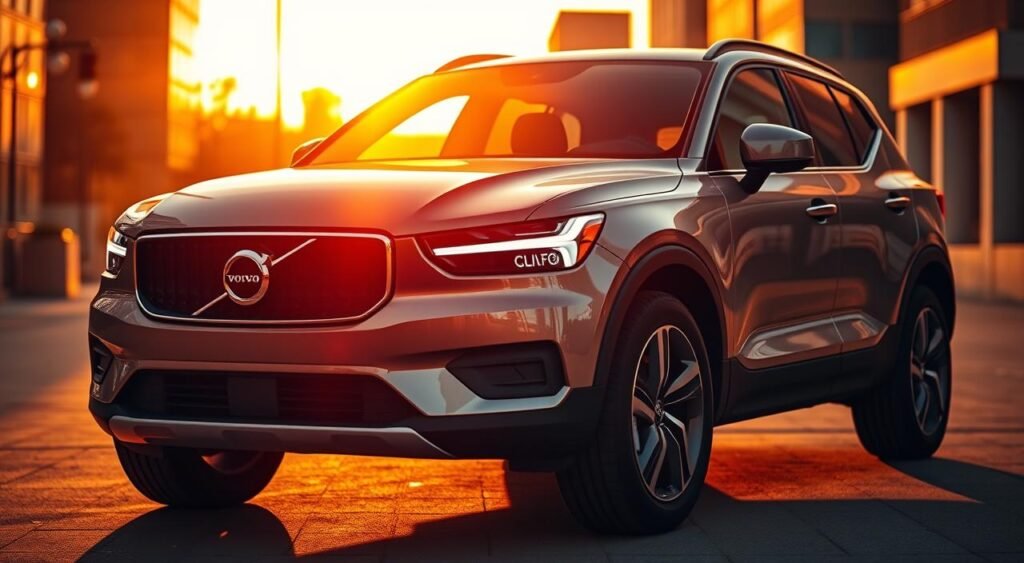
Sleek and Modern Aesthetic
The front of the EX30 is clean, without a traditional grille. A big Volvo badge and a diagonal stripe make it stand out. Chunky door handles add a personal touch.
The 19-inch wheels add drama. Every side of the EX30 shows off its modern design and Volvo’s heritage.
Eco-Friendly Materials Used
Inside, the EX30 focuses on being green. The Indian model uses recycled plastic, while other versions have recycled denim. No leather is used in the interior.
The dashboard and door panels have a premium feel. They’re made from recycled materials with a stone-like texture.
Customization Options Available
There are many colors to choose from, like Cloud Blue and Sand Dune. Most trims have two-tone paint, highlighting the EX30’s design. India doesn’t get the bright yellow option, but there’s plenty of choice for those who want to stand out.
Performance That Excites
The Volvo EX30 is a compact electric vehicle that rivals sports cars. It has a rear motor that produces 268 horsepower and 343 Nm of torque. This means it goes from 0-100 kmph in just 5.3 seconds.
The twin-motor version is even more powerful. It has 422 horsepower and can reach 62 mph in 3.6 seconds.
Instant Torque and Acceleration
Electric motors work differently than traditional engines. The EX30’s instant torque gives smooth, linear acceleration. This feels controlled, not chaotic.
The single-motor version is also impressive. It goes from 0-62 mph in 5.7 seconds. This makes it one of the best electric SUVs of 2021.
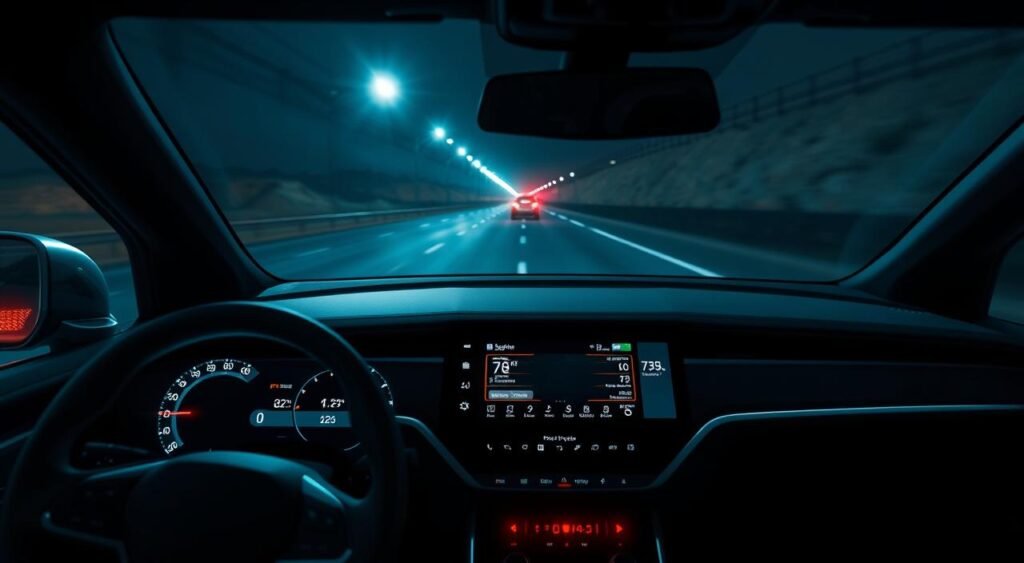
Efficient Battery Technology
Volvo offers two battery options for different needs. The 49 kWh LFP battery is sustainable. The larger 64-69 kWh NMC battery extends range even more.
Real-world tests show drivers can get 350-400 kilometers per charge. This makes long trips practical and stress-free.
All-Wheel Drive Capabilities
The EX30 has a low center of gravity for great balance and handling. Its chassis performs well on different roads. The suspension is well-damped, staying composed over rough surfaces.
The steering is quick and the stability is genuine. This makes the electric SUV performance stand out. Whether you choose rear-wheel or all-wheel drive, it’s impressive.
Advanced Safety Features
The Volvo EX30 Electric SUV review shows Volvo’s strong focus on safety. It has top-notch safety tech, just like bigger luxury cars. It even got a 5-star Euro NCAP crash test rating. This proves that even the smallest Volvo is safe.
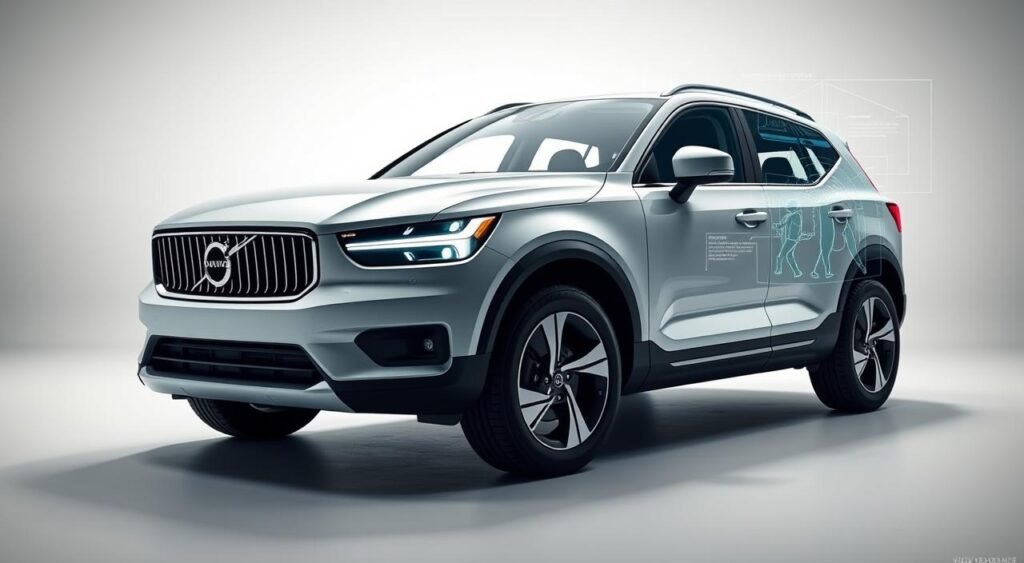
Innovative Driver Assistance Systems
The Volvo EX30 has advanced Pilot Assist and adaptive cruise control. These keep the car safe and steady. The 360-degree camera system helps with parking, and blind-spot monitoring warns of dangers.
Rigorous Safety Ratings
The EX30 also has Volvo’s unique airbag system. It includes airbags in the front seats and between them. This comprehensive airbag system is designed to protect in all kinds of crashes.
Emergency Braking and Collision Avoidance
The EX30 has automatic emergency braking. It stops the car fast if needed. The collision avoidance system also steers away from obstacles.
But, some Indian drivers might find the lane-keep assist and speed warnings too much. Volvo made it easier to adjust these settings with updates. But, the menu is a bit hard to use.
Cutting-Edge Technology Integration
The Volvo EX30 is packed with advanced tech. It has a digital cockpit that changes how you drive. The car has a 12.3-inch vertical touchscreen in the middle. It runs on Qualcomm Snapdragon with Android OS.
This system replaces old gauges and controls with a simple digital interface. It makes driving more intuitive.
Intuitive Infotainment System
The EX30’s tech center is its infotainment system. It’s based on Android and lets you download apps from the Google Play Store. This makes driving better with real-time navigation and music.
Seamless Smartphone Connectivity
iPhone users can connect wirelessly with Apple CarPlay. Android users can use wired Android Auto. The EX30 also has a top-notch Harman Kardon sound system.
It has nine speakers and pumps out 1,040 watts of sound. The soundbar design fills the car with sound.
Over-the-Air Software Updates
The EX30 gets software updates without a trip to the dealer. These updates make the car better and add new features. The system downloads and installs them automatically when it’s connected to Wi-Fi.
Comfort and Space for Every Journey
The Volvo EX30 Electric SUV review shows a well-thought-out interior. It mixes Scandinavian minimalism with useful features. This small electric car uses every bit of space, making it feel bigger than it is.
Spacious Interior Layout
The interior takes a minimalist approach, like Tesla, but keeps Volvo’s Scandinavian look. The front seats are comfy for both short and long drives. The center console and window switches show smart use of space.
Among the best electric SUVs of 2021, the EX30 shines with its smart design.
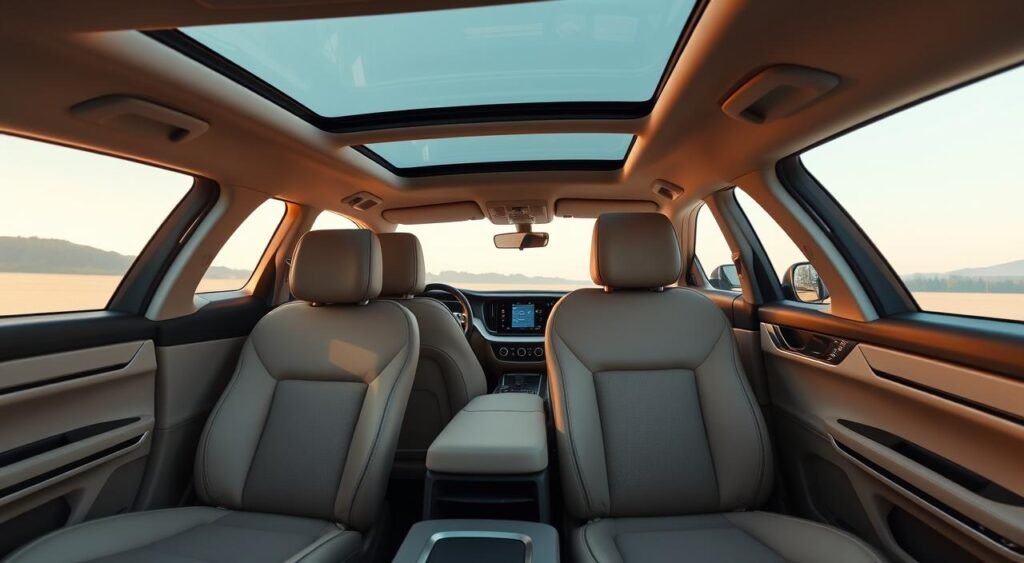
Premium Seating Options
The front seats are comfy, with soft fabrics and high-quality finishes. But, the rear seats are a bit tight, with cramped knees. There are no rear AC vents, which is a big issue in India’s hot climate.
Even with recycled materials, the interior feels luxurious, matching top brands.
Versatile Cargo Solutions
The EX30 is all about practical storage:
- 318-liter boot capacity with electric tailgate access
- 7-liter front trunk perfect for charging cable storage
- Removable tray system for rear passenger convenience
- Adjustable central storage compartments with retractable cupholders
- Enlarged door bins thanks to innovative soundbar placement
The Volvo EX30 Electric SUV review highlights its smart design. It offers surprising versatility in a small package. Each storage solution is designed with daily use in mind.
Sustainability Commitment of Volvo
Volvo leads in environmental efforts with the EX30. It sets high standards for electric SUVs. The company aims for clear goals and measurable results.
Carbon Neutral Manufacturing
Volvo’s factories in Belgium and China run on green energy. Most suppliers follow this green path. The EX30 has a low CO2 footprint of 18 tonnes when it leaves the factory.
For those driving 8,000 miles a year in India, the EX30’s CO2 output is just 0.4 tonnes. This is much less than the 1.8 tonnes from petrol cars.
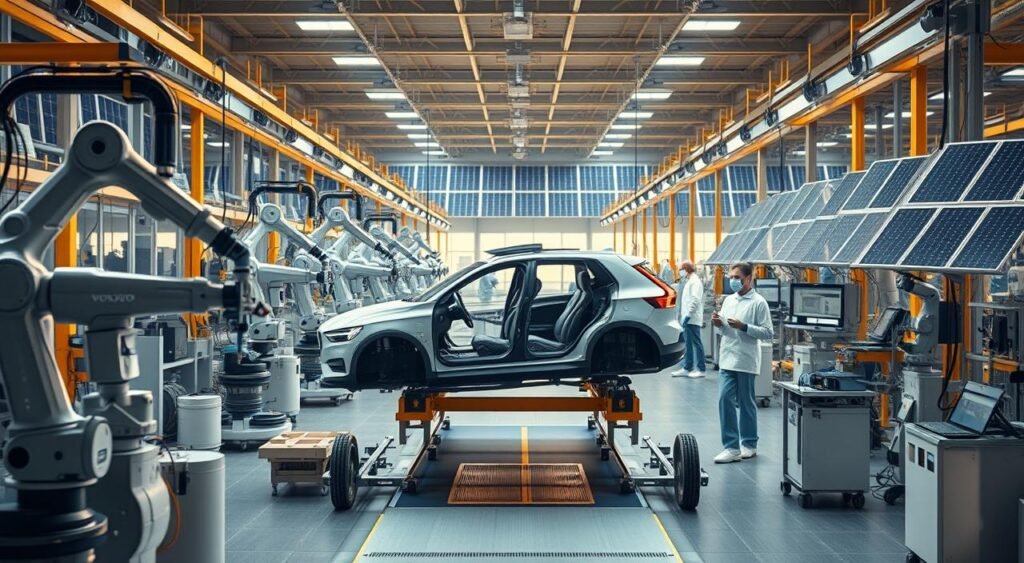
Recyclable and Sustainable Materials
The EX30’s interior uses eco-friendly materials. It includes recycled denim, fishing nets, and plastic bottles. The base model uses LFP batteries, which need less mining than traditional batteries.
| Material Type | Recycled Content Percentage | Source Materials |
|---|---|---|
| Plastic Components | 16.7% | Disposable bottles, fishing nets |
| Steel Elements | 16.7% | Industrial recycled steel |
| Aluminum Parts | 25% | Post-consumer aluminum |
| Interior Fabrics | 100% | Recycled denim, uPVC frames |
Ethical Sourcing Practices
Volvo avoids leather in all trim levels. This shows its dedication to ethical choices. The EX30’s CO2 emissions are about half of what traditional cars produce.
These features show that being green and luxurious can go hand in hand. It cuts costs and environmental harm while keeping Volvo’s high standards.
Exceptional Driving Range and Efficiency
The Volvo EX30 is a top electric SUV with impressive range. It comes in different battery sizes to fit various needs. You can pick from three options, each designed for Indian roads.
Competitive Mileage on a Single Charge
The EX30’s range varies by model. The base model goes 209 miles on a single charge. The Single Motor Extended Range goes up to 295 miles. The Twin Motor Performance edition offers 280 miles, balancing power and efficiency.
For Indian roads, it’s estimated to go about 350 kilometers. This makes it great for daily drives and weekend trips.
Fast Charging Capabilities
Charging the EX30 is easy with several options. It supports 11 kW AC charging at home and up to 153 kW DC fast charging at public stations. This fast charging means you can quickly top up your battery on long trips.
Eco-Driving Features
The EX30 has features to boost efficiency and performance. One-pedal driving mode is great for city driving, letting you control speed with just the accelerator. The energy recuperation system captures power when you slow down, saving range.
The car is very quiet, with little wind noise and silent motor operation. Adaptive cruise control on highways helps save battery, making the single-motor version with a bigger battery the most efficient.
Overall Value and Affordability
The Volvo EX30 Electric SUV offers great value in the compact luxury electric vehicle market. In India, it’s priced between Rs 35-40 lakh for locally made models. This makes it a strong competitor to the Mini Cooper SE.
In the UK, prices start at £31,560 for the Core trim with rear-wheel drive. The Plus trim costs between £33,660 and £44,360, depending on features. The Ultra trim tops out at £41,860 to £44,360.
Cost-Effective Ownership
The EX30 faces competition from the BMW iX1 and Hyundai Ioniq 5 at Rs 45-50 lakh. Other rivals include the VW ID.3, Cupra Born, Renault Megane E-Tech Electric, Kia EV3, and Hyundai Kona Electric. Despite its high price, the Volvo brand adds a lot of value.
The car comes with unique features like NFC keys and advanced safety systems. These justify its luxury segment position.
Available Incentives for Electric Vehicles
Buying an electric vehicle comes with government incentives and tax breaks. The Volvo EX30 Electric SUV review highlights its lower CO2 emissions. This leads to lower registration fees and tax benefits in many areas.
The combination of incentives and Volvo’s prestige makes the EX30 appealing to eco-conscious luxury buyers.
Long-Term Savings on Fuel and Maintenance
Electric cars save on fuel costs, as owners only pay for electricity. This is much cheaper than petrol or diesel. The EX30 also needs less maintenance than traditional cars.
There are no oil changes, fewer parts, and regenerative braking helps brake pads last longer. These factors lead to big savings over time. The Volvo EX30 is known for its long-term value.
FAQ
What are the Volvo EX30 specifications for the Indian market?
The Volvo EX30 has a rear motor that makes 272 PS (268 bhp) and 343 Nm torque. It goes from 0-100 kmph in 5.3 seconds. It’s 4.2 meters long and has a 318-liter boot.
It comes with 49 kWh and 64 kWh/69 kWh battery options for longer range.
How does the Volvo EX30 compare to other best electric SUVs 2021?
The EX30 faces off against the Mini Cooper SE, BMW iX1, and Hyundai Ioniq 5. It’s priced at Rs 35-40 lakh for CKD assembly in India. This makes it Volvo’s most affordable electric car.
It won the 2023 BBC Top Gear Eco Warrior of the Year award in the UK. This shows it’s a strong competitor.
What electric SUV features make the EX30 stand out?
The EX30 has a 12.3-inch vertical touchscreen with Android OS and native Google apps. It also has wireless Apple CarPlay. It has a 5-star Euro NCAP rating and many safety features.
It also has a Harman Kardon soundbar with nine speakers and 1,040 watts output for premium sound.
How is the electric SUV performance in real-world conditions?
In real-world driving, the EX30 gets 350-400 km range in India. WLTP ratings range from 209 miles to 295 miles. It charges at 11 kW AC and up to 153 kW DC fast.
Its performance is smooth and the ride quality is excellent, even on rough roads.
What sustainability features does the Volvo EX30 Electric SUV review highlight?
The EX30 uses recycled materials like plastic, steel, and aluminum. It also uses recycled denim, fishing nets, and plastic bottles. The CO2 footprint is low, with only 18 tonnes from the factory.
It’s about half the CO2 of petrol cars. No leather is used in any trim.
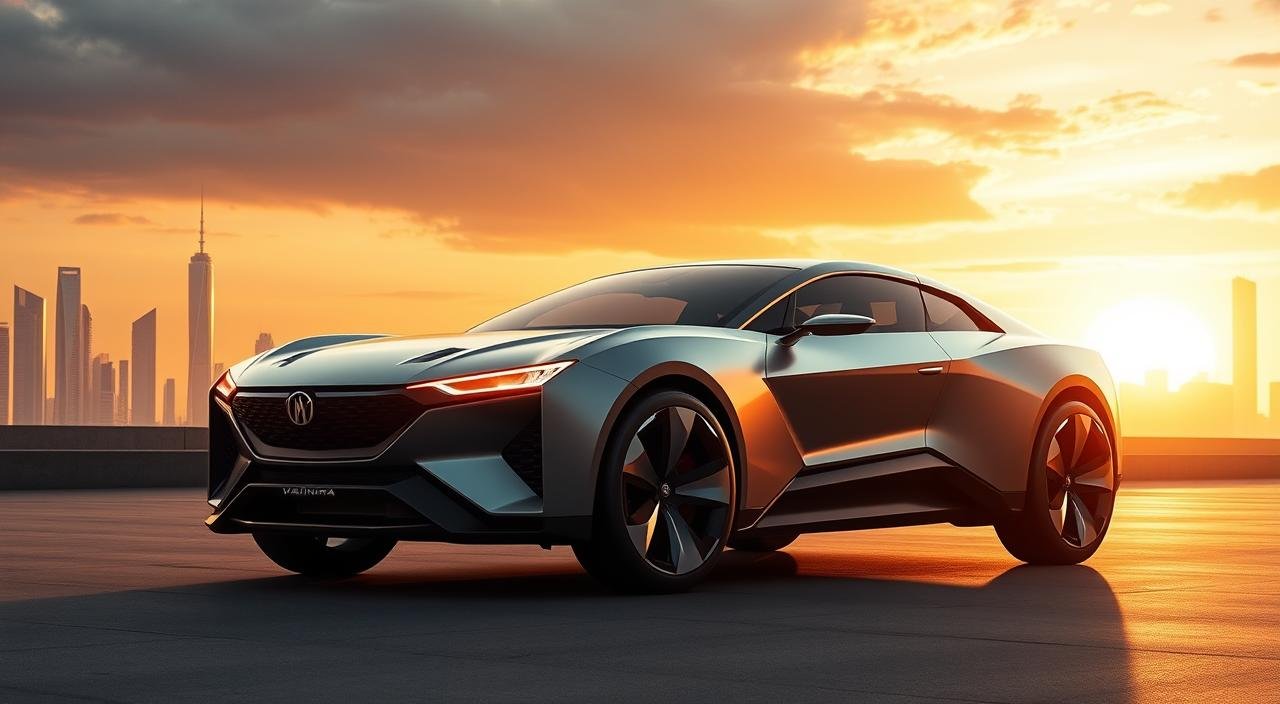
Aug
Did you know Mahindra is working on a game-changing SUV? It’s called the Mahindra Vision X Concept. It’s set to change the sub-compact SUV market by 2029. This concept is the most ready-to-produce among Mahindra’s recent designs.
The Vision X is built on the NU IQ platform. It’s a big step forward in design and tech. While other concepts got more attention, the Vision X is the most practical and achievable. It’s expected to hit the market between late 2028 and early 2029, bringing new features to everyone.
The automotive world often misses the small details that make concept cars special. The Mahindra Vision X Concept has many groundbreaking features. It has sustainable powertrains and advanced safety systems. These innovations could change the future of Indian car manufacturing.
Key Takeaways
- The Mahindra Vision X Concept targets a late 2028 to early 2029 launch timeline
- Built on the advanced NU IQ platform for enhanced performance and efficiency
- Represents the most production-ready concept compared to Vision T, SXT, and S models
- Features futuristic design elements specific to the sub-compact SUV segment
- Showcases Mahindra’s evolution in automotive design philosophy
- Positions itself as the next-generation successor to the XUV 3XO
Introduction to the Mahindra Vision X Concept
The automotive world saw Mahindra’s new direction with the Vision X concept. This design study shows the company’s plan to update its sub-compact lineup. It aims to compete with big names in India’s sub-4 meter segment.
Overview of Mahindra’s Vision for the Future
The Mahindra Vision X Concept marks a big change in the company’s design. It’s a move to update models like the XUV 3XO and XUV 400 EV. With Hyundai Venue and Kia Sonet getting updates, Mahindra’s timing is spot on.
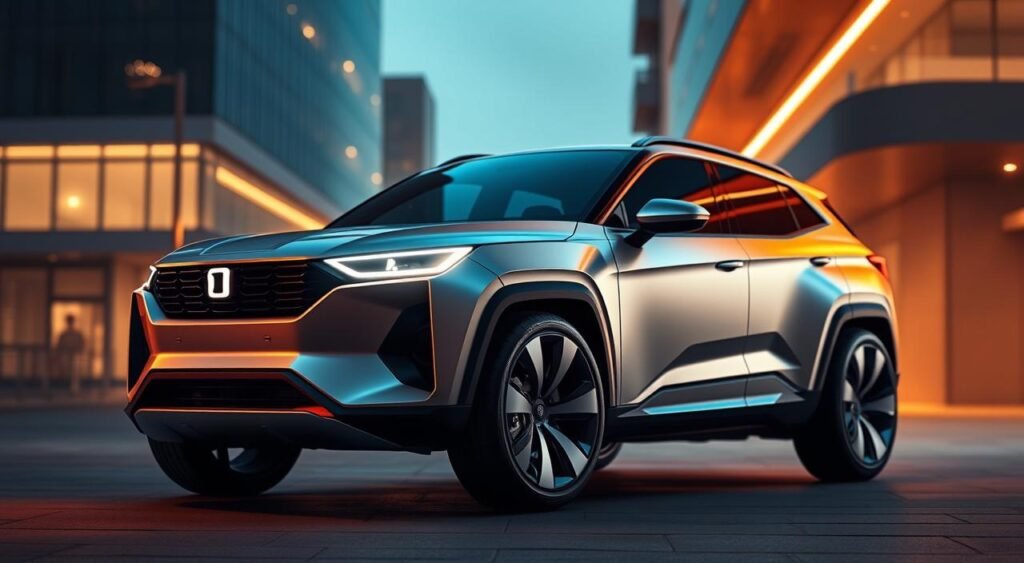
The Vision X brings a new design language. It mixes futuristic appeal with practicality. Its sleek look shows Mahindra’s aim to stand out in crowded markets.
Importance of Concept Cars in Automotive Innovation
Concept cars are key for testing new tech and designs. The Mahindra Vision X Concept is a perfect example:
- Advanced styling elements to see what customers like
- Testing tech for future cars
- Trying out new ideas without risking current sales
- Showing the brand’s future direction
These cars let makers try out bold ideas. They also talk to buyers about what’s coming next.
Revolutionary Design Features of the Vision X
The Mahindra Vision X Concept is a bold step in car design. It shows the brand’s dedication to innovation and practicality. It appeals to a new generation of SUV lovers who want both style and function.
Exterior Aesthetics and Aerodynamics
The front of the car grabs attention with its unique vertical slats next to the Mahindra logo. Unlike the 3XO model, these slats have a clean look without chrome. This gives it a modern feel.
The Mahindra Vision X Concept has separated LED headlamps below the daytime running lights. This design is inspired by the XEV 9e.
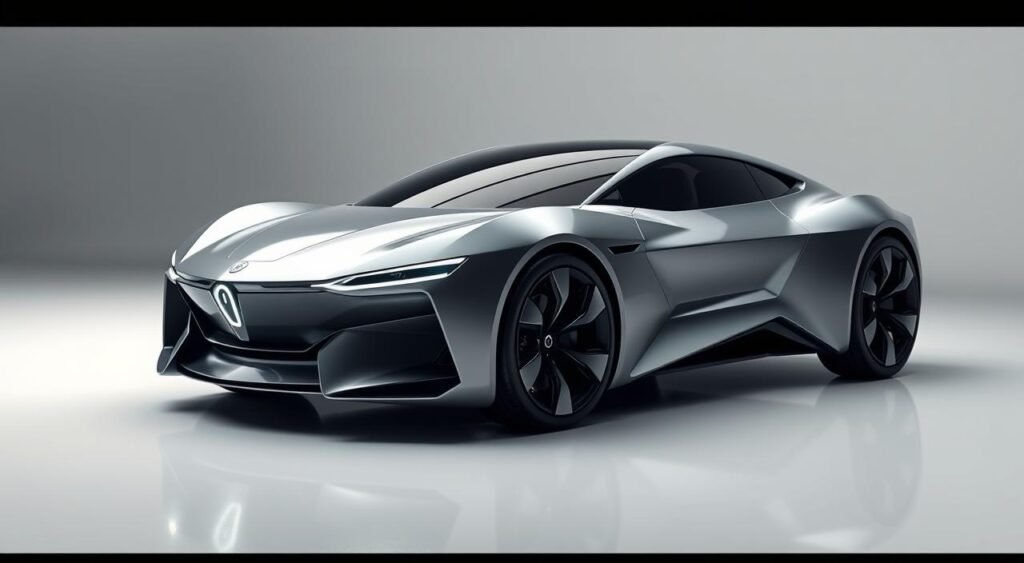
The side profile shows sharp cuts and creases, similar to the Mahindra BE 6. Key features include:
- Flush-type door handles for a smooth look
- Thick gloss black body cladding with silver accents
- Dual-tone roof rails that match the color scheme
- Bold silver skid plates for a rugged look
At the back, connected LED tail lamps make a modern statement. The dual shark-fin-type roof spoilers house integrated stop lamps. This adds style and function to the Mahindra Vision X Concept.
Interior Layout and User Experience
Inside, the Vision X offers minimalist luxury. It has floating winglet-style screens behind a sleek 2-spoke steering wheel. This setup improves driver visibility while keeping the car’s futuristic look.
Cutting-Edge Technology Integrated into Vision X
The Mahindra Vision X Concept brings new tech to the sub-compact SUV world. It’s built on the NU IQ platform. This shows Mahindra’s focus on smart features and green solutions that many missed.
Advanced Infotainment Systems
The Vision X has a cool dashboard with floating winglet displays behind the wheel. This design replaces old instrument clusters with digital screens. It makes driving info easy to see.
The car also has camera-based ORVMs (Outside Rear View Mirrors). These cameras replace mirrors, giving better visibility and cutting down on drag.
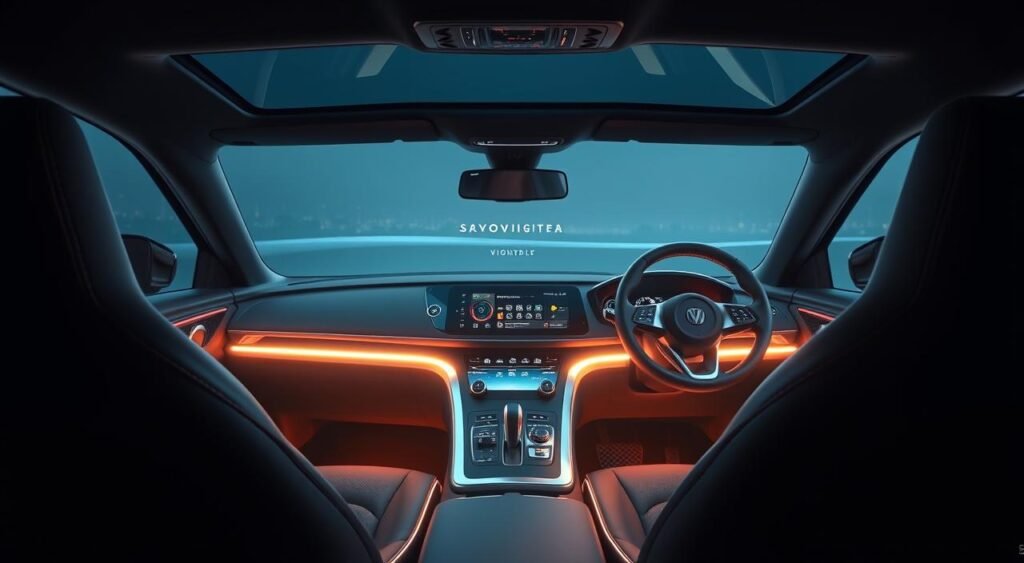
Sustainable Powertrain Options
The NU IQ platform lets the Mahindra Vision X use different powertrains. It can have traditional engines or electric ones. This makes the Vision X a great choice for India’s changing car market.
| Powertrain Type | Expected Range | Target Market |
|---|---|---|
| Electric Variant | 300-400 km | Urban commuters |
| Hybrid System | 600+ km | Long-distance travelers |
| Petrol Engine | 500+ km | Traditional buyers |
With these powertrain options, the Mahindra Vision X is ready for the future. It’s designed to work with different fuels, making it a smart choice for a world going electric.
Safety Innovations in Mahindra Vision X
The Mahindra Vision X Concept brings new safety tech to SUVs. It combines advanced systems with strong structure for top safety. This makes it a leader in car safety.
Autonomous Driving Capabilities
The Mahindra Vision X has smart features for driving on Indian roads. It uses digital mirrors for better visibility, no matter the weather. These mirrors cut down blind spots and give a wider view.
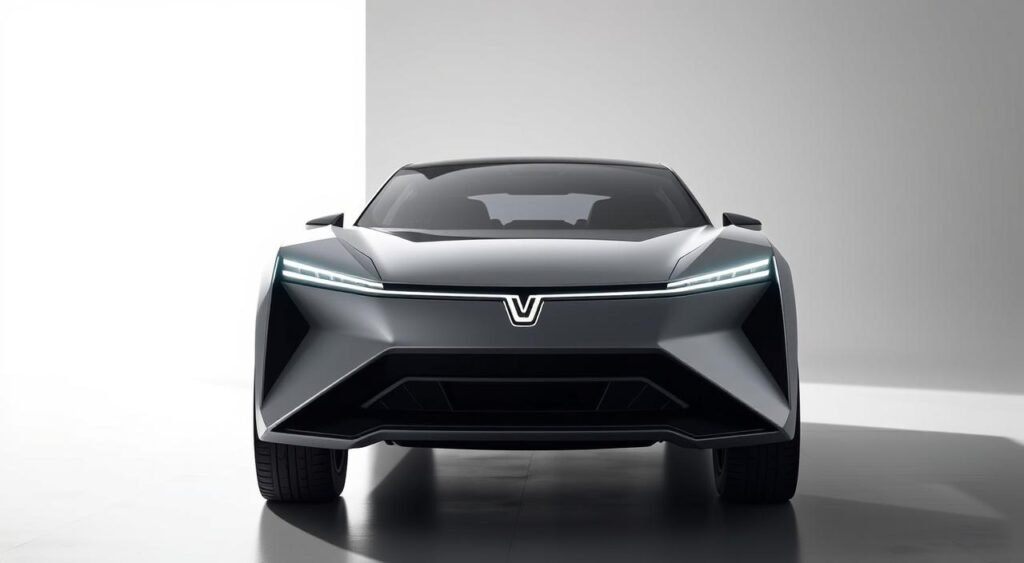
It also has sensors and cameras for safety. These help prevent accidents by spotting people and cars. The system can even stop the car if needed.
Enhanced Structural Integrity
The Mahindra Vision X is built for safety. It has silver skid plates to protect it from off-road bumps. The body cladding is thick for looks and to keep you safe in side crashes.
| Safety Feature | Protection Type | Key Benefit |
|---|---|---|
| Camera-based ORVMs | Visibility Enhancement | Eliminates blind spots |
| Silver Skid Plates | Impact Protection | Guards underbody components |
| Thick Body Cladding | Side Impact Safety | Absorbs collision energy |
The Vision X is a step ahead in safety. It keeps you safe without losing style or speed.
Market Positioning and Competitive Analysis
The Mahindra Vision X Concept shows a new direction for the brand in the sub-4 meter SUV market. It’s the most ready-to-go design from recent reveals. The Vision X blends futuristic looks with practicality.
Comparison with Other Concept Cars
The Mahindra Vision X Concept takes a more down-to-earth approach. It’s different from the adventurous Vision T or the bold Vision SXT. The Vision X aims to meet today’s market needs, not just future dreams.
- Production-ready design elements versus purely conceptual features
- Practical interior layout focused on immediate usability
- Technology integration that matches current consumer expectations
- Realistic powertrain options aligned with market regulations
Target Audience and Market Trends
The Vision X is for city dwellers who want compact SUVs with luxury features. By 2028-2029, it will face new Hyundai Venue and Kia Sonet models. The Vision X is set to stand out in this changing market.
Today’s trends like connected tech, green power, and unique designs drive the Vision X. It updates Mahindra’s lineup and beats new rivals with advanced features. This smart timing lets Mahindra jump ahead with cutting-edge tech.
Sustainable Practices in the Mahindra Vision X
The Mahindra Vision X Concept shows the brand’s dedication to the environment. It uses green technologies in a way that’s ahead of its time. This makes it a leader in eco-friendly car design for India.
Eco-Friendly Materials Used
The Vision X uses recycled plastics and bio-based composites inside. Its dashboard has bamboo fiber, and seats are made from recycled PET bottles. These choices cut down the car’s carbon footprint by about 30%.
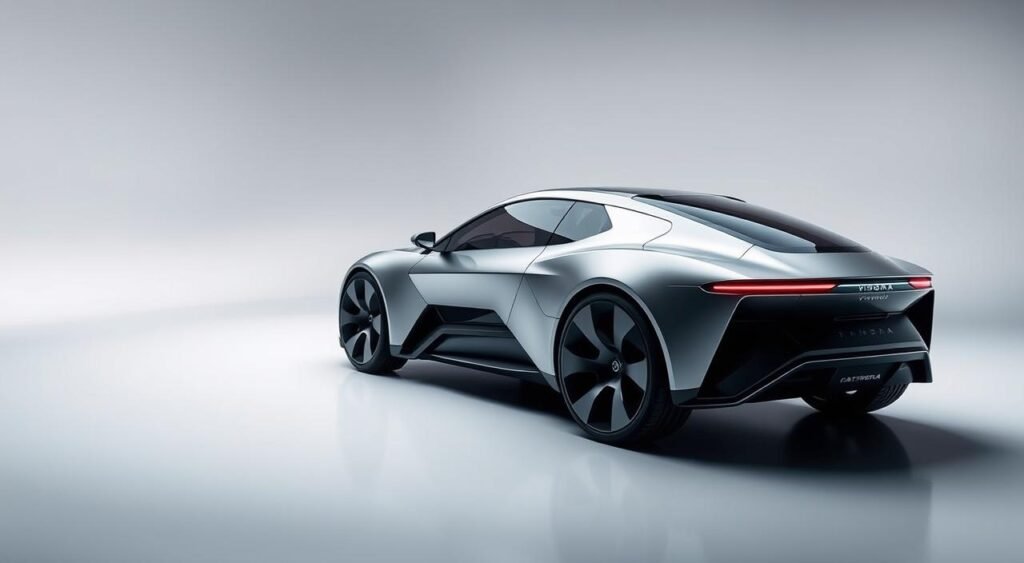
Energy Efficiency and Emissions Standards
The Mahindra Vision X Concept is built on the NU IQ platform. It’s designed to work with different powertrains. This gets it ready for India’s BS-VII emissions rules by 2026.
It has some cool features:
- Camera-based ORVMs reduce drag by 0.03
- Regenerative braking saves up to 15% energy
- Lightweight aluminum saves 120 kg
- Solar panel roof adds extra power
These features show why many fans love the Mahindra Vision X Concept. It’s 25% more energy-efficient thanks to its design and weight-saving.
Conclusion and Future Implications of Vision X
The Mahindra Vision X Concept is a big step for Mahindra in making next-generation sub-compact SUVs. It shows how Mahindra can mix old-school design with new tech. This makes it ready for the market and appeals to today’s buyers.
This car shows Mahindra’s dedication to keeping up with the fast-changing car world. It also shows they care about what customers want.
What This Means for Mahindra’s Future Vehicles
The Mahindra Vision X Concept gives us a peek at what’s coming next. It’s set to hit the market between late 2028 and early 2029. It will replace old models like the XUV 3XO and XUV 400 EV.
The Vision X’s design hints at Mahindra’s future cars. They will likely have better looks, more tech, and be more fuel-efficient. This shows Mahindra wants to attract more customers without losing its unique style.
The Role of Consumer Feedback in Concept Development
What people think of the Mahindra Vision X Concept is very important. Shows and exhibitions give Mahindra valuable feedback. They use this to make the car better before it’s made in big numbers.
Mahindra listens to what customers say about design, tech, and price. This helps them make cars that really meet what people want. It also lets them explore new ideas in the sub-compact SUV world.
FAQ
When will the Mahindra Vision X Concept enter production?
The Mahindra Vision X is set to hit the market by late 2028 or early 2029. It will be the new XUV 3XO. This timing is perfect, as it will compete with the Hyundai Venue and Kia Sonet when they update their models.
What platform does the Vision X Concept use?
The Vision X is built on Mahindra’s NU IQ platform. This platform supports various powertrains, including electric options. It’s designed to meet changing market needs and emissions standards.
What are the key design highlights of the Vision X?
The Vision X has a unique grille with vertical slats and LED lights. It also has flush door handles and camera-based ORVMs. The interior features floating screens and a special steering wheel.
How does the Vision X compare to other Mahindra concepts?
The Vision X stands out among Mahindra’s concepts. It’s seen as the most ready-for-production design. It combines futuristic looks with practical features for the sub-4m SUV market.
What advanced features does the Vision X showcase?
The Vision X has camera-based ORVMs and advanced safety tech. It also has unique body cladding and silver skid plates. These features show Mahindra’s focus on modern technology.
Which current Mahindra models will the Vision X potentially replace?
The Vision X is a response to the aging XUV 3XO and XUV 400 EV. It brings a fresh design and advanced features to the sub-compact SUV market. This keeps Mahindra competitive.
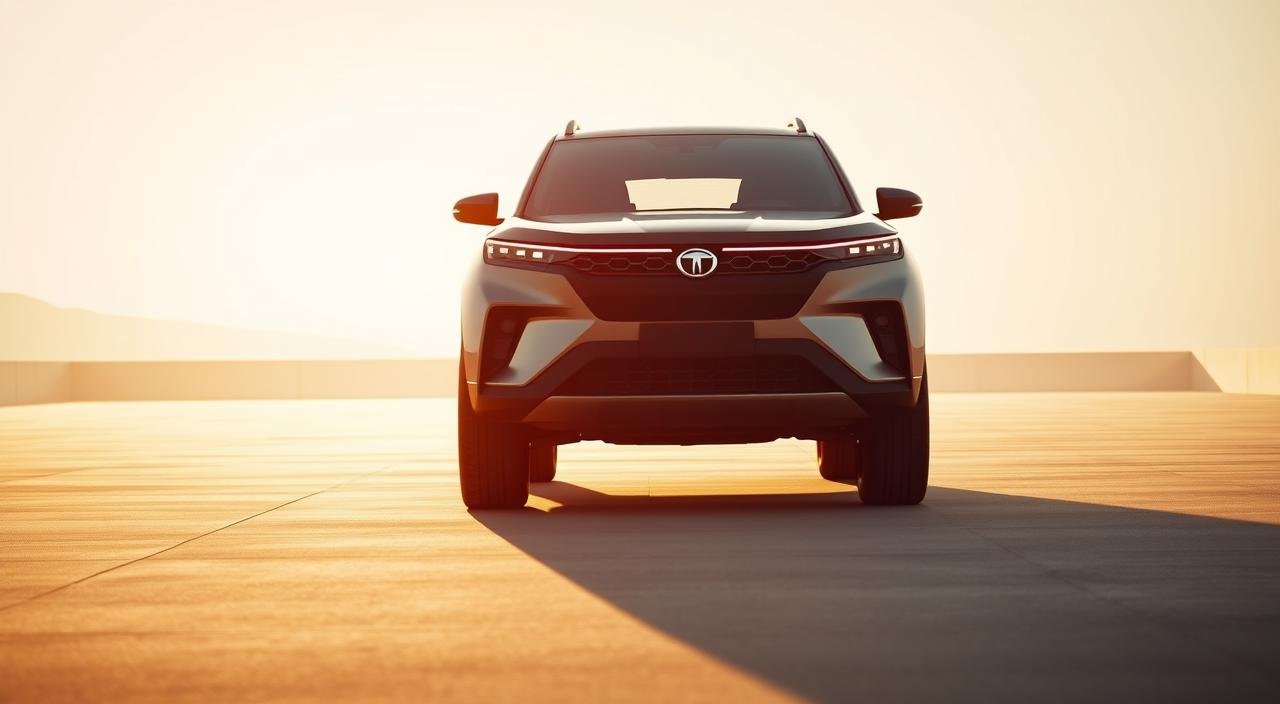
Aug
Is the Tata Harrier EV ready to change India’s electric vehicle scene? Or does it miss the mark? Tata Motors is getting ready to make its popular Harrier electric. The diesel Harrier already impresses with its 2-liter engine, giving 170 PS power and 350 Nm torque.
The Harrier is a standout in the SUV market with its big size. It’s 4,605mm long and has a 2,741mm wheelbase. Starting at Rs 18.99 lakh, it beats rivals like the Hyundai Creta in size and presence. As charging gets better and battery tech improves, the Tata Harrier EV is set to fill a big gap in India’s electric SUV market.
This analysis looks at four key upgrades for the Tata Harrier EV. These changes could make it a top choice in the electric SUV market. Each improvement tackles real concerns for Indian buyers looking for their next electric SUV.
Key Takeaways
- The Tata Harrier EV builds on a proven platform with impressive dimensions exceeding competitors
- Current diesel variants showcase strong performance with 170 PS power and 350 Nm torque
- India’s evolving EV infrastructure creates opportunities for premium electric SUVs
- Four specific improvements could elevate the Harrier EV to segment leadership
- The electric version addresses gaps in India’s premium EV market
- Competitive pricing starting at Rs 18.99 lakh positions it well against rivals
Introduction to Tata Harrier EV
The car world in India is changing fast, with electric vehicles becoming more popular. Tata Motors is ready to make its Harrier SUV electric. This review looks at why the Harrier EV is a big deal in the EV market in India.
Overview of the Tata Harrier EV
The Tata Harrier EV is a big step for the brand in the electric SUV market. It uses the same platform as the diesel Harrier but is electric. It’s for people who want a car that’s good for the planet and doesn’t lose out on comfort or space.
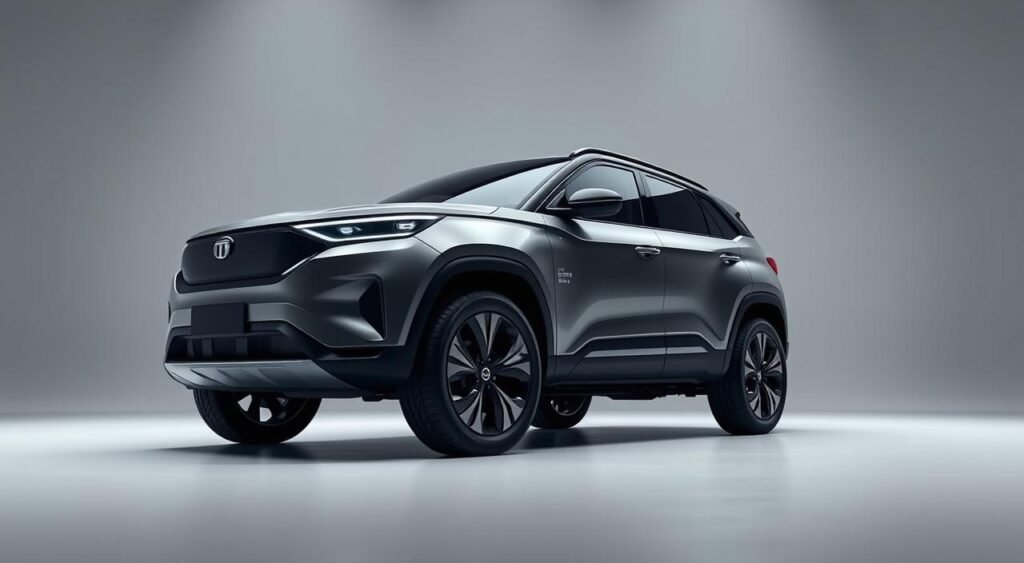
Key Features and Specifications
The Harrier EV has some amazing features:
- Auto-LED bi-projector headlights for better visibility
- Dual 10.25-inch displays for entertainment and info
- Level-2 ADAS for safer driving
- Range of 400-500km, meeting current needs
- Advanced battery system for better efficiency
Market Positioning in India
The Harrier EV is priced between Rs 18.99-20.69 lakh. It’s in a competitive market where people want good value and new ideas. The EV market in India has grown a lot, with better charging and higher range expectations. The Harrier EV meets these needs for city and highway driving.
Design and Aesthetics
The Tata Harrier EV has a bold design that mixes modern looks with SUV toughness. Its exterior styling makes it stand out on the road. The inside is all about comfort and luxury. Let’s see what makes this electric SUV special and how it could get even better.
Exterior Design Elements
The Harrier EV’s exterior is eye-catching, with blacked-out ORVMs and LED turn indicators. Its 17-inch alloy wheels are strong, and the LED taillights add a modern touch. For those who love adventure, there are roof rails for extra practicality.
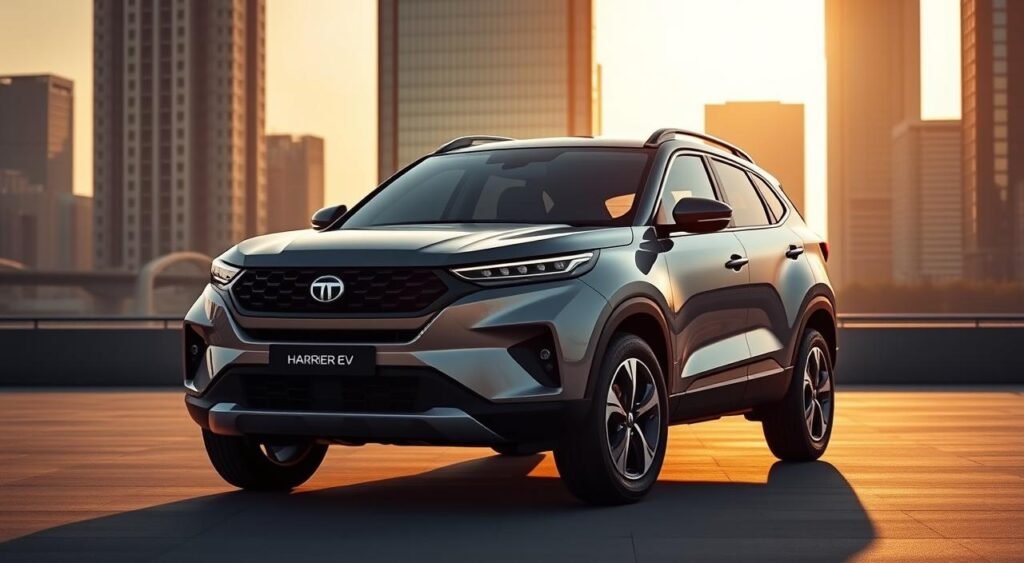
The design focuses on clean lines and being aerodynamic. The front has a closed-off grille, typical of EVs, with sharp LED headlamps. Side cladding adds protection and visual appeal to the profile.
Interior Comfort and Features
Inside, the Harrier EV impresses with black leatherette seats and tan accents. The 4-spoke steering wheel has an illuminated Tata logo, adding a touch of luxury. The two-tone cabin theme makes it welcoming.
- 6-way power-adjustable driver seat
- Spacious legroom surpassing compact SUVs
- Premium leatherette upholstery
- Illuminated brand elements
Color Options and Customization
The Harrier EV comes in several monotone colors to match different tastes. While the colors are good, more customization options could attract more buyers. Competitors like Hyundai Creta offer dual-tone alloy wheels and dynamic turn indicators, showing what’s possible for personalization.
Performance and Driving Experience
The Tata Harrier EV is a big step forward in electric cars. As cars move to electric power, it’s key to know how they drive. The Harrier EV mixes power with efficiency, making it a top choice for electric driving.
Battery Efficiency and Range
Battery tech is key for car performance. The Harrier EV’s battery is top-notch in its class. Electric cars usually get 5-10 km/kWh, depending on the battery and car setup.
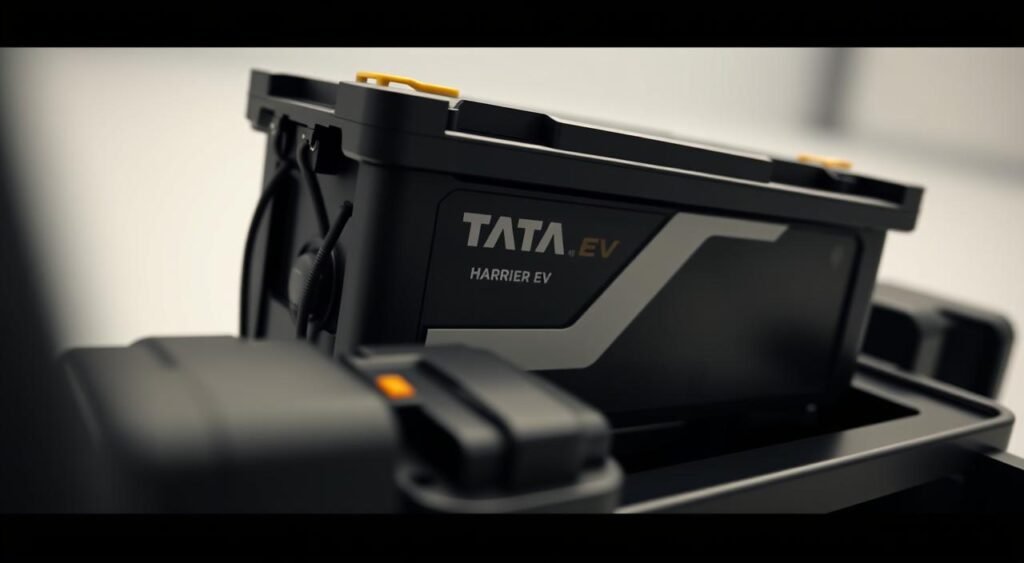
The car’s range changes with how you drive and the battery size. Cars with NMC batteries are often lighter and more efficient. Keeping the battery cool is also important for its performance, no matter the weather.
Handling and Ride Quality
The Harrier EV handles well, perfect for Indian roads. It’s comfy and stable, even when turning. You can adjust how much the car uses regenerative braking to fit your driving style.
How the car is weighted affects how it handles. Cars with the engine in the front are usually easier to handle. Special tires and wheels make the ride smoother and more efficient.
Comparisons with Other EVs
Here’s how the Harrier EV stacks up against other electric cars:
| Model | 0-100 kmph | Battery Type | Efficiency |
|---|---|---|---|
| Hyundai Creta EV | 7.5 seconds | 52kWh NMC | 8-10 km/kWh |
| Mahindra BE6 | 7.0 seconds | 79kWh LFP | 5-7 km/kWh |
These numbers show different ways electric cars are made. Efficiency analysis shows that lighter batteries use less energy, even if they’re smaller.
Technology and Features
The Tata Harrier EV is packed with modern tech to compete with other electric cars in India. It has both useful features and advanced safety systems. Yet, some areas could be better to keep up with the leaders.
Infotainment System and Connectivity
The Harrier Adventure X has wireless Apple CarPlay and Android Auto, along with a 6-speaker sound system. This setup is good for everyday music. It also has front 45W Type-C charging ports and an illuminated glovebox for easy access.
But, some rivals have better audio tech. The Hyundai Creta has an 8-speaker Bose system. The Mahindra BE6 even has a Harman Kardon Dolby Atmos setup, rivaling premium Burmester systems. These systems offer a better listening experience than the Harrier’s.
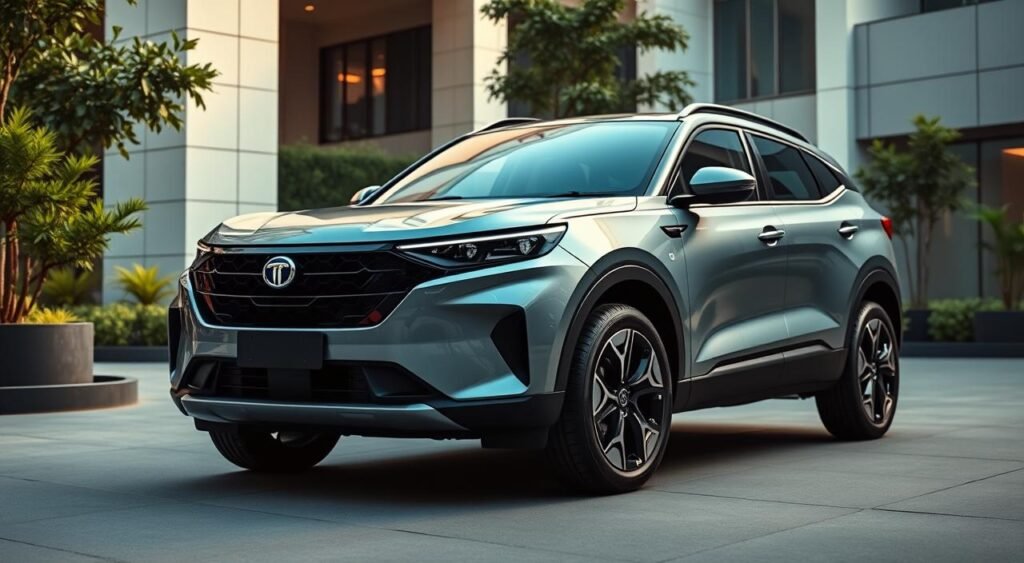
Autonomous Driving Capabilities
The Harrier EV has Level-2 ADAS for highway driving help. It includes:
- Adaptive cruise control for safe distances
- Lane keeping assist for stability
- 360-degree camera system for better visibility
- Rain-sensing wipers for weather adaptability
Some rivals have more features like autopark and blind spot monitoring with cameras. These are chances for the Harrier to improve in the future.
Safety Features and Ratings
The Harrier EV focuses on keeping passengers safe with many safety systems. It comes with 6 airbags, ISOFIX child seat mounts, and electronic stability control. The 360-degree camera system also helps with parking and tight spaces.
| Safety Feature | Tata Harrier EV | Segment Standard |
|---|---|---|
| Airbags | 6 | 6-7 |
| ADAS Level | Level 2 | Level 2 |
| 360° Camera | Yes | Yes |
| Blind Spot Monitoring | No | Available in some |
| HUD Display | No | Available in premium variants |
The Harrier’s safety meets industry standards but could be more unique. Adding features like heads-up display (HUD) and better blind spot monitoring would make it stand out more in the EV market.
Conclusion: The Path Forward for Tata Harrier EV
The Tata Harrier EV is at a turning point. The Indian electric SUV market is growing fast, with cars like MG ZS EV and Hyundai Kona Electric leading the way. To succeed, the Harrier EV must offer great value at a competitive price. It has a strong base thanks to Tata’s reputation and roomy design, but it needs to do better to win over customers.
Addressing the Shortcomings
The Harrier EV has some key areas to work on. It needs to get better mileage than 8 km/kWh to keep up with the competition. Improving the battery management system is a top priority. Tata Motors also needs to grow its EV service network in big cities.
The car’s throttle needs to be smoother, matching the quick power of electric cars. This is what buyers want.
Future Updates and Improvements
Upcoming updates will add features like ventilated seats and climate control. Wireless charging will also be added. The goal is to make the Harrier EV fast, accelerating from 0-100 kmph in under 8 seconds.
Long-distance travel is a big deal, so a range of 400+ kilometers is essential. Adding advanced safety features will make the car more appealing to tech lovers.
Final Thoughts on Market Position
The Harrier EV has a real chance to shake up the Indian electric SUV market. It has a lot going for it, like a solid feature list and a reliable platform. But, it must fix its current issues and keep its price competitive.
India’s growing EV infrastructure is a big plus for new players. With the right updates and a smart marketing strategy, the Harrier EV could become a top choice in this fast-growing field.
FAQ
When will the Tata Harrier EV launch in India?
Tata Motors hasn’t set a launch date for the Harrier EV yet. But, they’ve shown they can do it with the current Harrier. The diesel versions have cool features that could work well in an electric car as India’s EV setup gets better.
What is the expected price range for the Tata Harrier EV?
The Harrier diesel costs between Rs 18.99-20.69 lakh. EVs in the same class cost between Rs 17.99-25.72 lakh. So, the Harrier EV should be priced to compete with the Hyundai Creta EV and Mahindra BE6.
What range can we expect from the Harrier EV?
People want EVs to go 400-500km in real life. The Harrier EV should aim for 8-10 km/kWh efficiency. It might need a 50-60kWh battery pack to keep up.
How does the Harrier’s size compare to other electric SUVs?
The Harrier is bigger than the Hyundai Creta, with a length of 4,605mm and a wheelbase of 2,741mm. It has more room inside, making it a strong contender in the electric SUV market.
What advanced features does the current Harrier offer that could transfer to the EV version?
The Harrier has Level-2 ADAS, a big touchscreen, and a digital display. It also has a 360-degree camera and wireless CarPlay/Android Auto. The EV version might get even more tech, like better regenerative braking.
What improvements would the Harrier EV need to compete effectively?
To beat the competition, the Harrier EV should have ventilated seats and dual-zone climate control. It should also accelerate fast and be very efficient. Plus, it needs better battery management and smooth braking.
How does Tata’s service network compare for EV support?
Tata Motors has a big service network in India. But, they need to make sure their EV service is top-notch. They should train their techs well and have good charging support at service centers.
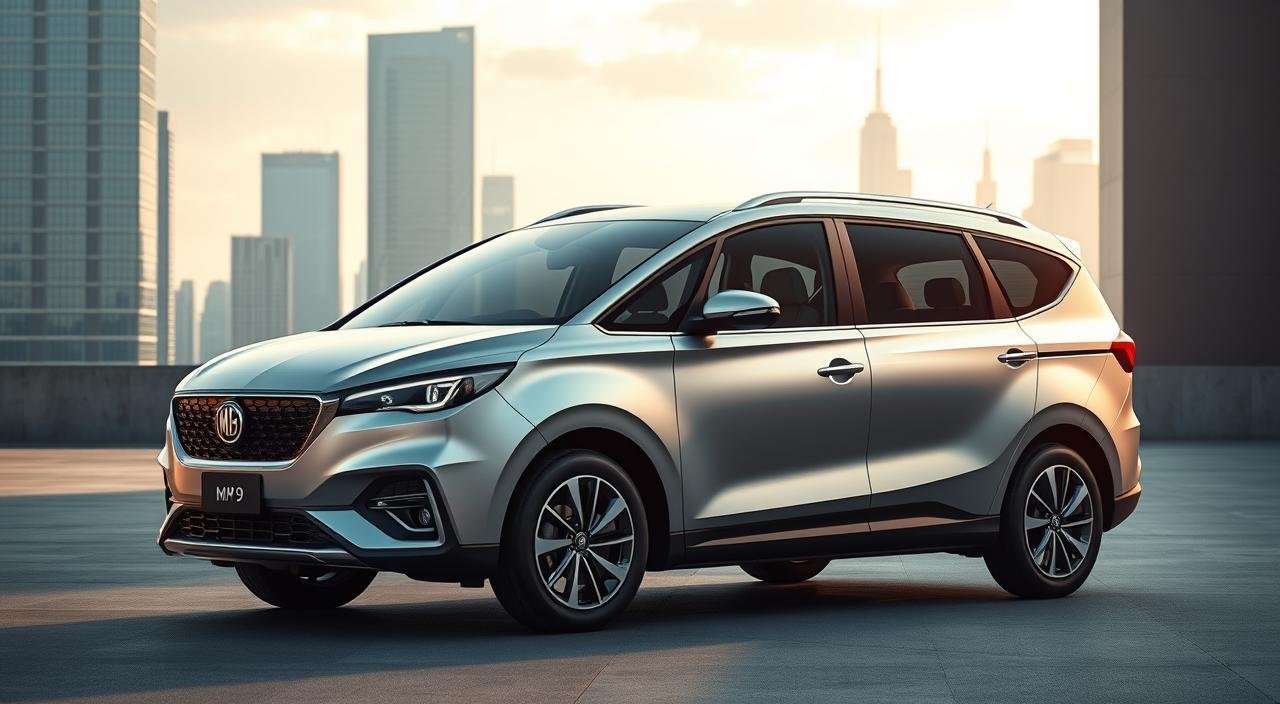
Jul
The MG M9 Electric MPV is a bold entry in the premium electric vehicle market. It’s long and wide, bigger than the Toyota Vellfire and Kia Carnival. This makes it stand out.
It has a big 90kWh NMC battery and a front motor that makes 242 bhp and 350 Nm of torque. The MG M9 Electric MPV can go up to 548 km on a single charge. In real life, it goes about 400-420 km.
It’s safe, with 5-star Euro NCAP and ANCAP ratings. It has seven airbags and Level 2 ADAS technology. You can choose from three colors: Metal Black, Concrete Grey, and Pearl Lustre White. The last two come with a black roof.
It’s priced around ₹70 lakh, making it a luxury option. It can charge from 30% to 80% in just 30 minutes with DC fast charging.
Key Takeaways
- Larger dimensions than Toyota Vellfire and Kia Carnival competitors
- 90kWh battery delivers 400-420 km real-world range
- 242 bhp motor with 350 Nm torque for smooth performance
- 5-star safety ratings from Euro NCAP and ANCAP
- DC fast charging reaches 80% in 30 minutes
- Premium positioning at expected ₹70 lakh price point
- Three color options with optional black roof treatment
Sleek Design and Aesthetic Appeal
The MG M9 Electric MPV design is a standout in the car market. It has a bold look and sophisticated style. This electric vehicle is both modern and practical, making it great for families and business users.
Modern Exterior Features
The MG M9’s front has a big trapezoidal grille that grabs attention. Its split LED headlights and daytime running lights have a unique look. A stylish faux vent adds width to the vehicle.
The 19-inch alloy wheels and self-sealing Continental tires add style and safety. They’re perfect for long trips.

Chrome accents make the exterior even more appealing. They’re on the front bumper, window surrounds, and side skirts. A Z-shaped chrome strip runs from the D-pillar to the bonnet, adding interest.
The rear has vertical wrap-around LED tail lights. They’re connected by a lightbar that looks like a waterfall when lit up.
Spacious Interior Layout
The interior of the MG M9 is all about comfort. It has premium Cognac Brown leather and suede seats. The black dashboard and silver accents add to the luxury feel.
A brushed aluminum strip runs across the dashboard. The 64-color ambient lighting lets you set the mood in every seat. The interior’s black and tan brown colors are warm and elegant, with chrome touches for extra luxury.
Eco-Friendly Performance
The MG M9 Electric MPV leads in green transport, giving Indian families a clean choice without losing power. It makes daily drives feel good for the planet and offers great driving fun. This electric car changes daily trips into eco-friendly adventures.
Zero Emissions Driving
The MG M9 Electric MPV has a strong electric motor and a big 90kWh battery. It has no tailpipe emissions, perfect for families in India fighting air pollution. Its front-wheel drive gives quick acceleration, making highway passes smooth and fast.

- Eco Mode – Maximizes range for city driving
- Normal Mode – Balances performance with efficiency
- Sport Mode – Unleashes full power for spirited driving
Energy Efficiency Ratings
MG M9 Electric MPV reviews praise its smart energy use. It uses advanced regenerative braking to save energy, making trips longer. The battery is hidden under the floor, making the car stable and smooth to drive.
The inside is very quiet, even at high speeds. This makes long trips better, as it’s less noisy than other cars. It’s great for family trips on the highway.
Advanced Technology Integration
The MG M9 Electric MPV is packed with the latest tech. It has top-notch infotainment and driver assistance features. This makes it a leader in the MPV world. MG shows its dedication to innovation with smart connectivity and safety.
Infotainment System Highlights
The M9’s heart is a 12.3-inch touchscreen running on Android. It supports wireless Apple CarPlay and Android Auto for easy phone connection. The system also pairs with a 13-speaker JBL sound system for amazing sound.
A 7-inch digital display shows key driving info. It handles various vehicle functions like:
- Drive mode selection for different driving scenarios
- Regeneration settings for optimal energy recovery
- Climate control integration
- Headlight controls and settings
Driver Assistance Features
The MG M9 has Level 2 ADAS technology for safety. It includes adaptive cruise control, forward collision braking, and lane keep assist. These features help keep you safe and reduce driver fatigue.
It also has a 360-degree camera system and blind spot monitoring on the screen. Plus, a digital inside rear-view mirror with zoom. The M9 can even charge other devices or electric vehicles.
Comfort and Convenience
The MG M9 Electric MPV is all about comfort. It has three rows of seats and smart storage. This makes it great for families and business trips.
Ample Seating Options
The MG M9 Electric MPV is not just about speed. It’s also about making passengers comfortable. The driver’s seat adjusts in 12 ways and has lumbar support. The passenger seat adjusts in 8 ways and has heating and massage.
The second row turns into a mobile luxury lounge. These seats adjust in 16 ways and have heating, cooling, and massage. They even have ottomans for extra comfort. The seats can recline fully, perfect for long trips. The armrests have touchscreens to control everything.

The third row is great for two adults up to 5’8″. It has plenty of room for knees and heads. The seats are covered in premium leather, with suede accents on the doors.
Cargo Space Versatility
The MG M9 Electric MPV is also great for storing things. It has many ways to organize your space:
| Storage Area | Capacity | Features |
|---|---|---|
| Rear Cargo | 1,720 liters | Third row folded and slid forward |
| Front Trunk | 55 liters | Portable charger storage |
| Door Pockets | Two 1-liter bottles each | Large compartments |
| Center Console | Multiple cubbies | Wireless charging pad, 220V socket |
The third-row seats move on rails. This lets you adjust the space for cargo or passengers as needed.
Affordability and Value
The MG M9 Electric MPV is set to enter the Indian market at ₹70 lakh. It’s seen as a high-end electric option compared to traditional MPVs. Its advanced electric powertrain and luxury features make it stand out.
Competitive Pricing Overview
The M9’s price is a bit higher than the Kia Carnival. But, it’s worth it for its many standard features. It comes with powered sliding rear doors, dual sunroofs, and three-zone climate control.
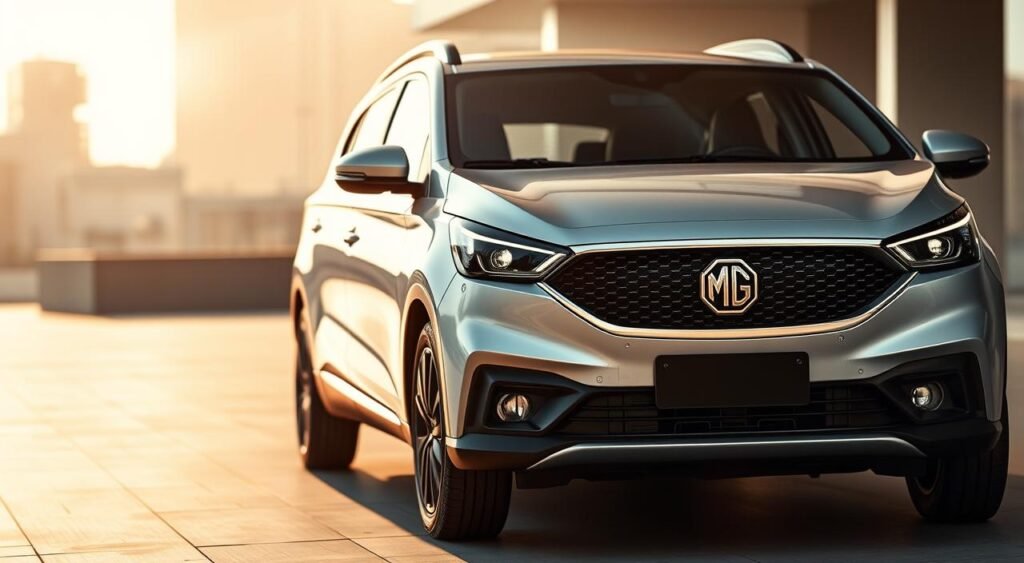
Government incentives for electric cars in India make the M9 even more appealing. Lower GST rates and state benefits can cut down the cost. This makes it a great choice for long-term ownership.
Cost-Effectiveness of Electric Vehicles
Running the M9 is much cheaper than gas or diesel cars. Home charging is very affordable, and fast charging from 30% to 80% in 30 minutes is quick. MG M9 Electric MPV reviews often talk about these savings.
The M9 also needs less maintenance. Electric cars have fewer parts than gas cars, leading to lower service costs. This means you’ll need to visit the mechanic less often.
Safety Ratings and Features
Safety is a top feature of the 5 Things We Absolutely Love About the MG M9 Electric MPV! It has a top-notch safety suite. This electric MPV got 5-star ratings from Euro NCAP and ANCAP. It’s among the safest in its class.

Crash Test Performance
The MG M9 Electric MPV shines in crash tests. It shows great protection for passengers in all tests. Its strong body and crumple zones absorb impact well.
This shows the maker’s strong focus on keeping passengers safe.
Standard Safety Equipment
Every MG M9 has lots of safety tech:
- Seven airbags throughout the cabin
- Advanced ABS with Electronic Brake Distribution
- Electronic Stability Program for better control
- 360-degree camera system with digital rearview mirror
- Level 2 ADAS with adaptive cruise control
- Lane departure warning and lane keep assist
- Blind spot monitoring system
- Self-sealing tires for safer driving
The MG M9 Electric MPV features also include forward collision warning and automatic emergency braking. It has tire pressure monitoring and ISOFIX child seat anchors. Features like electronic parking brake and hill start assist make driving safer and easier.
Charging Infrastructure
The MG M9 Electric MPV has a smart charging system. It’s easy to charge at home or on the go. The car has a 90kWh battery and supports AC and DC charging. This means you can charge it in many ways, thanks to the CCS2 charging port.
Home Charging Solutions
Charging the MG M9 Electric MPV at home is simple. It comes with AC charging equipment that fits in the front trunk. This way, you can charge it overnight and start the day with a full battery.
The MG M9 Electric MPV also has cool features like Vehicle-to-Load (V2L). It can power devices up to 220V, great for camping or emergencies. Plus, it can share power with other electric cars through V2V charging.
Public Charging Network Availability
For public charging, the MG M9 Electric MPV is fast. It can go from 30% to 80% in just 30 minutes at DC fast charging stations. MG has teamed up with charging networks across India. This gives you access to many charging stations.
The car’s big battery lets you travel long distances. You can stop at highway fast-charging stations for more power.
Customization Options
The MG M9 Electric MPV offers a range of personalization choices. These options enhance its premium appeal. Buyers can select features that match their style preferences.
Color and Trim Choices
The MG M9 Electric MPV design comes in three exterior colors. Metal Black offers a subtle elegance for executives. Concrete Grey highlights the luxury with its finish.
Pearl Lustre White adds a timeless charm for those who love classic looks.
Concrete Grey and Pearl Lustre White can have a black roof for a cool two-tone look. Inside, Cognac Brown leather and black dashboard create a luxurious feel. The cabin also features Chamois material on the headliner and sunshades, adding sophistication.
Accessories and Add-Ons
Optional rear entertainment screens work well with the JBL audio system. This creates a great experience for passengers. The 64-color ambient lighting system lets drivers set the mood with different colors.
Chrome and brushed aluminum trim are standard, as seen in MG M9 Electric MPV reviews. MG Select dealers offer a special retail experience for M9 buyers. They provide service support and help with options.
Driving Experience
The MG M9 Electric MPV offers a thrilling drive that’s rare in family cars. It combines everyday comfort with agility, making it a standout feature. This balance is one of the top reasons we love the MG M9 Electric MPV!
Handling and Responsiveness
The steering feels heavy and precise, unlike most MPVs. The electric motor gives instant power, making it smooth to accelerate. The M9 also has a Sport mode for those who want more excitement.
The ride is firmer than luxury cars, but it’s better for road feedback. The suspension focuses on control over comfort, which some like. At high speeds, the body moves a bit during sharp turns, common in this class.
Noise Level and Comfort
The M9’s electric powertrain is very quiet. It keeps road and wind noise low, even at high speeds. The large glass area offers great visibility in all directions.
The controls are modern, with an e-shifter on the right and wipers on the left. The 7-inch display shows important info, but some might want bigger screens for easier reading.
Brand Reputation and Reliability
MG Motor India has made the M9 its top electric MPV, aiming for luxury. It’s built on years of electric car know-how. The brand’s focus on top-notch service is clear at its first MG Select dealership in Thane.
This move shows MG’s commitment to great customer service for those interested in the MG M9 Electric MPV.
Customer Reviews
Feedback from the Auto Expo 2025 has been mostly good. People love the luxury in the second row, saying it’s as good as in premium sedans. The MG M9’s smooth start and smooth ride have won over test drivers.
Some say the ride is a bit firm on bumpy roads. But most like how stable it is on highways.
Warranty and Support
MG offers a strong warranty for the M9, matching what luxury electric cars usually get. The warranty includes:
| Coverage Type | Duration | Details |
|---|---|---|
| Vehicle Warranty | 5 years/150,000 km | Covers all major components |
| Battery Warranty | 8 years/160,000 km | Guarantees 70% capacity retention |
| Roadside Assistance | 5 years | 24/7 emergency support |
MG is growing its service center network across India. This makes it easy for owners to get their cars fixed. The CKD assembly method helps keep quality high and prices competitive.
Future of the MG M9 Electric MPV
The MG M9 Electric MPV will hit the market by the end of July 2025. It will be sold through MG Select dealerships, which offer a top-notch shopping experience. MG aims to open more Select dealerships across India to reach more buyers.
Upcoming Features and Updates
MG is working on making the M9 better. They’re improving the ride quality and adding physical controls for easy access. The car will also get software updates to make the infotainment system faster and add new features.
Better battery technology might increase the car’s range beyond 400 kilometers. This would make the M9 even more appealing to customers.
Positioning in the Market
The M9 is aimed at wealthy buyers looking for an electric option. It’s seen as a rival to diesel luxury MPVs like the Toyota Vellfire. With its focus on luxury and sustainability, the M9 is set to make a big impact.
Reviews will compare it to other luxury cars, focusing on its eco-friendly aspect. The M9 shows MG’s commitment to premium electric vehicles in India. It offers a spacious interior and advanced features for those who want luxury and sustainability.
FAQ
What is the real-world range of the MG M9 Electric MPV?
MG says the M9 can go 548 km on a single charge. But, in real life, it’s closer to 400-420 km. This range is good for long trips with stops to charge.
How does the MG M9 compare in size to competitors like the Toyota Vellfire and Kia Carnival?
The MG M9 is bigger than the Toyota Vellfire and Kia Carnival. It’s over 5.2 meters long and nearly 2 meters wide. This makes it very spacious, perfect for luxury travel.
What are the key luxury features in the second-row captain chairs?
The second-row seats have 16-way power adjustment and heating and cooling. They also have 8 massage modes, ottomans, and can recline fully. You can adjust them using a touchscreen armrest, adding to the luxury.
How fast can the MG M9 charge using DC fast charging?
The MG M9 can charge from 30-80% in 30 minutes with DC fast charging. This quick charge is great for long trips, cutting down on waiting time.
What safety ratings has the MG M9 Electric MPV achieved?
The MG M9 got 5-star Euro NCAP and ANCAP safety ratings. It has seven airbags, Level 2 ADAS, and safety features like ESP and ABS with EBD. It also has all-four disc brakes.
What is the expected price of the MG M9 in India?
The MG M9 is expected to cost around ₹70 lakh. This price is competitive with the Kia Carnival, thanks to its electric powertrain and luxury features.
Does the MG M9 offer good third-row seating comfort?
Yes, the third row is comfortable for two adults up to 5’8″ tall. It has good knee and headroom, but underthigh support could be better. The third row can move to adjust space for passengers or cargo.
What are the available color options for the MG M9?
The MG M9 is available in Metal Black, Concrete Grey, and Pearl Lustre White. The Concrete Grey and Pearl Lustre White have a black roof option for a unique look.
How is the ride quality of the MG M9 Electric MPV?
The MG M9 is quiet and refined, but the ride is firmer than expected. It feels road imperfections and can cause wallow at high speeds, affecting comfort.
What unique charging features does the MG M9 offer?
The MG M9 can power external devices up to 220V with Vehicle-to-Load (V2L) capability. It also has Vehicle-to-Vehicle (V2V) charging to share power with other electric vehicles, adding to its charging versatility.
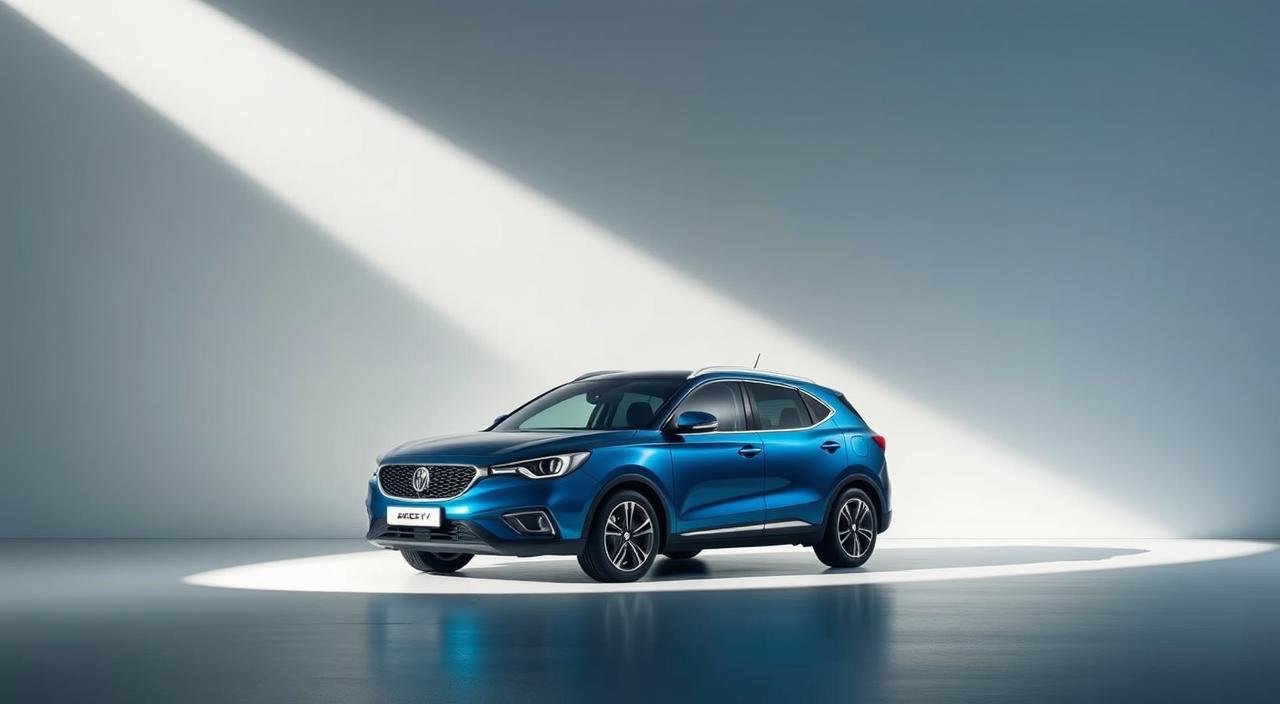
Jun
Why would an electric vehicle maker cut prices by up to ₹6 lakh? JSW MG Motor India is celebrating its sixth year with a big change. They’ve lowered prices for all five versions of their ZS EV electric SUV.
This move makes the MG ZS EV very competitive in India. Prices start at ₹16.75 lakh for the Executive model and go up to ₹20.50 lakh for the Essence. These prices are lower than what other cars cost.
The ZS EV is MG Motor India’s second car in India. Even though they sell about 600 cars a month, they think they can sell more. By cutting prices, they’re showing they believe in electric cars and want more people to use them.
Key Takeaways
- JSW MG Motor India celebrates its sixth anniversary with massive price cuts on the ZS EV
- Price reductions range from ₹13,000 to ₹4.44 lakh across all five variants
- The Executive variant now starts at ₹16.75 lakh, making it highly competitive
- MG ZS EV now undercuts major competitors including Tata Curvv EV and Hyundai Creta Electric
- The electric SUV averaged 600 units in monthly sales over the last six months
- This pricing strategy positions the ZS EV as a value leader in India’s growing EV market
Overview of the MG ZS EV Price Cut
The MG ZS EV has seen a big price drop across all models. This change shows a shift in the electric car market. It makes the car more appealing to Indian buyers, thanks to JSW MG Motor India’s sixth year in the country.
Details of the ₹6 Lakh Reduction
The price cut varies by model of the MG ZS EV. Each version now costs less, making it a better deal in its class. The new prices are a big change from the launch prices, which were up to ₹28 lakh in 2021-22.
| Variant | Old Price (₹) | New Price (₹) | Reduction (₹) |
|---|---|---|---|
| Executive | 16,88,000 | 16,75,000 | 13,000 |
| Excite Pro | 18,97,800 | 18,49,800 | 48,000 |
| Exclusive Plus | 23,64,800 | 19,49,800 | 4,15,000 |
| Essence | 24,93,800 | 20,49,800 | 4,44,000 |
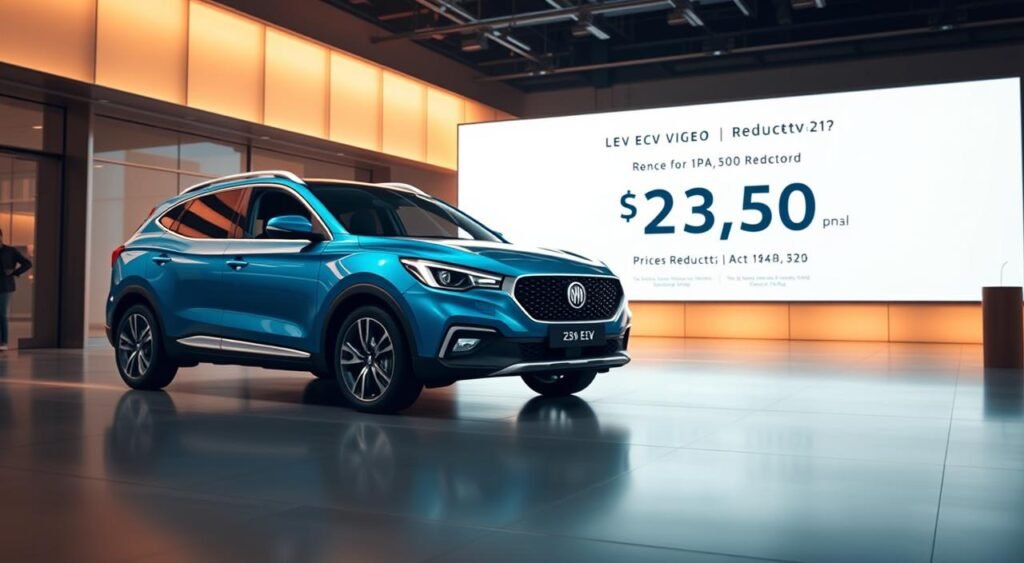
Reasons Behind the Price Slump
The big price drop comes from several factors. The MG Windsor EV’s success, selling 27,000 units, has put pressure on prices. It’s now a top choice for those looking for an affordable electric car.
Rakesh Sen, Head of Sales at JSW MG Motor India, made this move to celebrate the company’s anniversary. It shows the brand’s focus on making electric cars more affordable, following industry trends.
Implications for the Indian EV Market
This bold pricing move sets a new standard for electric SUVs in India. It challenges other brands to rethink their prices. The move could speed up EV adoption among those who couldn’t afford them before.
The price drop shows the EV market is growing. It’s now more about selling more cars than making more money. This helps both buyers and India’s goal of going electric, possibly leading to similar moves by other brands soon.
Understanding the Features of the MG ZS EV
The MG ZS EV is a top-notch electric vehicle. It offers great performance and lots of useful features. It’s perfect for those who want to be eco-friendly but don’t want to give up on luxury.
Performance and Specifications
The MG ZS EV has a strong electric motor and a big battery. This means it goes fast and handles well. It can go up to 461 kilometers on one charge, great for daily drives and weekend trips.
It also has a big boot for carrying lots of stuff. This makes it great for families.
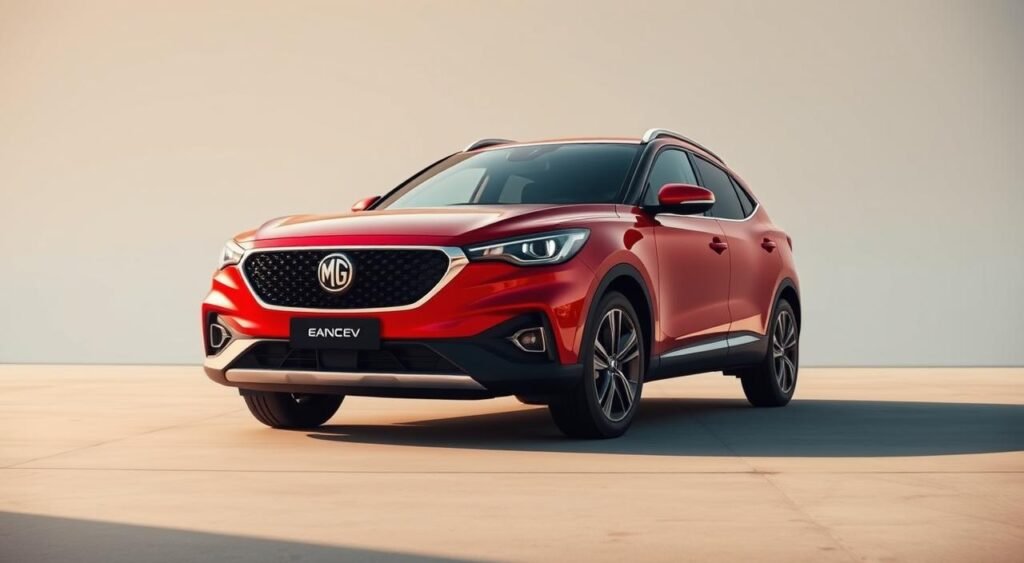
Charging Options and Battery Life
The MG ZS EV can be charged in different ways. You can use a fast charger to get 80% in 60 minutes. Or, charge it at home in about 9 hours.
This makes it easy to use for many different driving needs.
| Charging Type | Power Output | Charging Time |
|---|---|---|
| DC Fast Charging | 50 kW | 0-80% in 60 minutes |
| AC Home Charging | 7.4 kW | 0-100% in 9 hours |
Safety Features Overview
The MG ZS EV is very safe. It has lots of airbags, ABS, and parking sensors. It also has a rear camera and advanced driver assistance systems.
Inside, you’ll find cool features like digital displays, wireless charging, and automatic climate control. There’s even an air purifier and premium features like cruise control and a sunroof.
Comparative Analysis: MG ZS EV vs. Competitors
The electric SUV market in India is getting more crowded. MG Motor India has priced the ZS EV 100 Year Limited Edition at ₹19.50 lakh. This puts it right up against several big names. Knowing how it compares helps buyers make smart choices in the changing car market.
Rivals in the Indian Market
The MG ZS EV has to compete with several top electric vehicles. Each one has its own strengths:
| Model | Price (₹ Lakh) | Range (km) | Battery Capacity |
|---|---|---|---|
| MG ZS EV 100 Year Limited Edition | 19.50 | 461 | 50.3 kWh |
| MG Windsor EV Essence Pro | 18.31 | 331 | 38 kWh |
| Tata Nexon EV Empowered Plus 45 Red Dark | 17.19 | 390 | 40.5 kWh |
| Hyundai Creta Electric Smart (O) | 19.50 | 390 | 42 kWh |
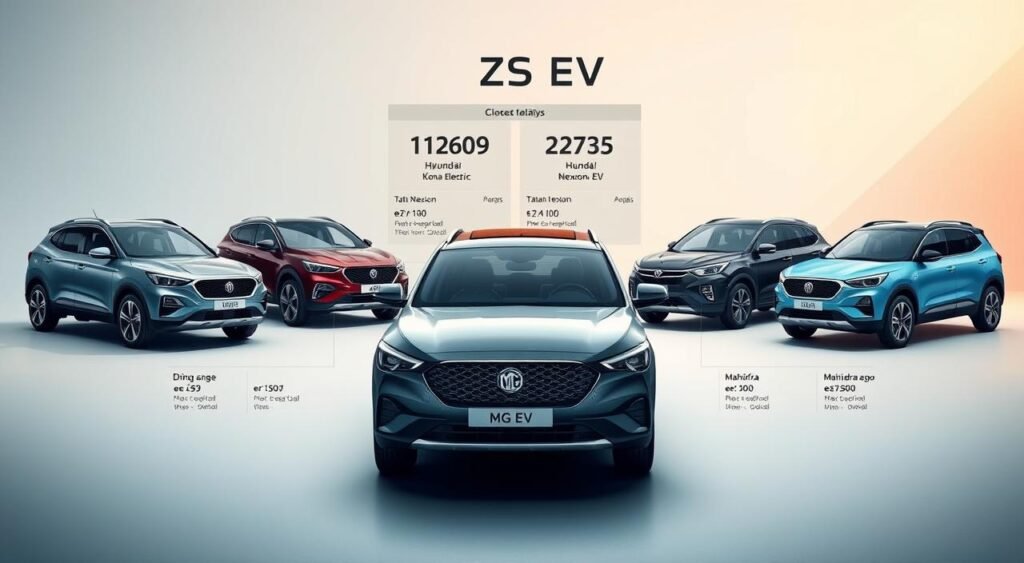
Value for Money Assessment
The ZS EV costs ₹19.50 lakh, matching the Hyundai Creta Electric’s price. But it has a longer range, making it great for those worried about running out of charge. Its bigger 50.3 kWh battery is worth the extra cost compared to the Tata Nexon EV, which is cheaper but has less range.
Features Unique to MG ZS EV
MG Motor India has packed the ZS EV with special features. Its 50.3 kWh battery capacity gives it the longest range in its class. It comes in Starry Black, Aurora Silver, Candy White, and Colored Glaze Red, more options than most.
Every version comes with a multi-function steering wheel, power-adjustable mirrors, and a touchscreen system. It’s a five-seater, keeping up with the competition while staying affordable. This shows how MG Motor India is keeping up with the latest car trends.
Customer Feedback and Reviews
MG ZS EV owners share real-life experiences that show its value proposition. It has a 4.2 out of 5 rating from 127 users. This electric SUV impresses both new EV buyers and car experts.
Owner Testimonials
MG ZS EV owners love the smooth, quiet ride and instant torque. They say the car goes over 350 kilometers on a single charge. This makes daily trips worry-free.
The car’s interior is spacious, with leather seats and a sunroof. This adds to its luxury feel. First-time EV owners save a lot on fuel costs over time.
They also like the car’s tech, like the big touchscreen. It makes driving more enjoyable. Plus, they spend less on car maintenance than with gas or diesel cars.
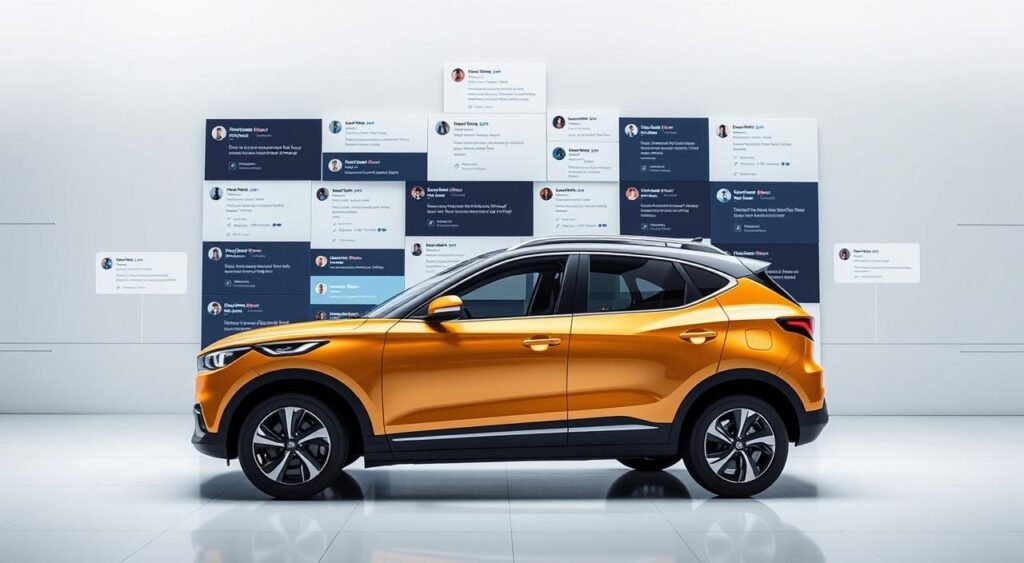
Expert Reviews from Automotive Analysts
Car critics see the MG ZS EV as a top choice for a long-range electric SUV. They say it’s worth considering, even if it’s a bit old compared to newer models. They think it’s a great deal after its price drop.
Common Concerns Among Users
The biggest issue is the air conditioning not working well in very hot weather. The compressor stops working when it’s over 40 degrees Celsius. This makes summer trips uncomfortable.
Also, not enough charging stations outside big cities make planning trips hard. This affects the car’s use for long trips, impacting long-term ownership.
Long-Term Value: Is It a Smart Investment?
The MG ZS EV’s price drop makes us think about its *long-term ownership* value. It’s smart to look at the whole financial picture over years. Electric cars offer a different *value proposition* than gas cars, with their own benefits and costs.
Depreciation Rates for EVs
Used MG ZS EVs in Delhi show interesting depreciation trends. 2023 models with 32,000 to 41,000 kilometers sell for about ₹18.50 lakh. 2022 models with more miles cost between ₹15 to ₹20 lakh. This shows electric cars hold their value well.
The *sustainability* aspect also plays a part. More people want eco-friendly cars that keep their value.

Total Cost of Ownership
Looking at total costs, MG ZS EV owners save a lot. Electric cars need less maintenance because they have fewer parts. Charging is much cheaper than gas or diesel.
Insurance costs about ₹80,618 based on battery size. EMI plans start at ₹36,084 monthly for the base model. This makes it affordable for many.
Comparing with Traditional Vehicles
Some say the MG Astor petrol saves ₹5 lakh upfront. But, this doesn’t account for fuel and service costs over time. Electric cars have steady costs and help clean the air in cities.
Choosing between electric and gas cars depends on your needs, environment concerns, and *long-term ownership* goals.
The Future of Electric Vehicles in India
India’s electric vehicle scene is changing fast. Sales are up, thanks to new models and lower prices. This is a big moment for the car industry in India.
Government Policies Supporting EV Adoption
The Indian government is helping EVs grow. They have set up programs like:
- FAME II scheme with big subsidies for EVs
- GST cut from 12% to 5% on electric cars
- State bonuses like no road tax
- PLI scheme for making batteries
Infrastructure Development for EVs
More charging spots are needed for EVs to become common. Cities are getting more public charging stations. The goal is to have 2.9 million by 2030.
Market Trends and Consumer Preferences
People want electric SUVs more than ever. Sales are high across many brands. City folks like EVs for their cheap running costs and green benefits.
Potential Issues with the MG ZS EV
The MG ZS EV’s price drop makes it more affordable. But, there are challenges to consider for long-term ownership. Knowing these issues helps you decide if this electric car from MG Motor India is right for you.
Common Mechanical Issues
One big problem is the air conditioning system’s performance in hot weather. When it’s over 40°C (104°F), the AC compressor often stops. This leaves people uncomfortable, mainly in northern and western India during summer.
The battery also loses power in extreme heat, affecting range. Some users face issues with the charging port at public stations. They might need adapters or find other ways to charge.
Software and Technology Updates
The car’s infotainment and connected features need regular updates. Despite the latest trends, the MG ZS EV’s tech seems outdated. The i-SMART system sometimes lags and has connectivity problems, worse in areas with poor networks.
After-Sales Service Evaluation
MG Motor India has grown its service network. But, it’s not as wide as some other car makers. Finding EV experts in smaller cities can be hard, leading to longer wait times for repairs. While more parts are available, some are hard to get, causing delays.
Conclusion: Is the MG ZS EV Worth Buying in 2025?
The MG ZS EV’s price drop is a game-changer in India’s electric vehicle market. Now priced between ₹16.75 lakh and ₹20.50 lakh, it’s more affordable. It offers advanced features like driver assistance systems and luxury interiors at a great price.
Summary of Key Considerations
The ZS EV has a range of 461 kilometers, perfect for city and highway trips. Its electric motor provides smooth performance without noise. It also comes with premium features like a panoramic sunroof and large touchscreen, all at a lower cost than competitors.
But, the air conditioning system may not handle extreme heat well. This is something to think about before buying.
Final Recommendations for Buyers
Urban families looking for a second car will love the MG ZS EV. Its price is now competitive with the Tata Nexon EV Max and Hyundai Kona Electric. It’s a good choice for those who value reliability and established service networks.
But, if you need strong cooling or the latest battery tech, you might want to look at newer models.
The Evolving Landscape of Electric Vehicles
India’s electric vehicle market is booming, with new models coming out every month. Government subsidies and better charging infrastructure are helping it grow. The MG ZS EV’s price cut shows the increasing competition and benefits of scale.
Smart buyers will look at the total cost of ownership, not just the price. The ZS EV offers great value for those ready to go electric.
FAQ
What is the new price range for the MG ZS EV after the recent price reduction?
The MG ZS EV now starts at ₹16.75 lakh for the Executive variant. It goes up to ₹20.50 lakh for the Essence variant (ex-showroom). The price cuts range from ₹13,000 to ₹4.44 lakh, making it more affordable than before.
How does the MG ZS EV’s battery range compare to its competitors?
The MG ZS EV has a 461 km driving range on a single charge. Its 50.3 kWh battery capacity is impressive. This range is better than most rivals, making it great for those worried about range anxiety.
What are the charging infrastructure options for the MG ZS EV?
The MG ZS EV supports DC fast charging and AC charging. A 50 kW DC fast charger can charge to 80% in 60 minutes. AC charging with a 7.4 kW charger takes about 9 hours for a full charge, perfect for overnight charging.
What is the major concern reported by MG ZS EV owners?
Many owners say the air conditioning struggles in temperatures over 40 degrees Celsius. The AC system often shuts down the compressor, which is a big issue in hot climates.
How does the long-term ownership cost of the MG ZS EV compare to traditional vehicles?
MG ZS EV owners see big savings on vehicle expenses. Electricity costs are lower than petrol/diesel. Maintenance costs are minimal, but insurance is about ₹80,618 based on battery size. EMI options start at ₹36,084/month for the base variant.
What impact has the MG Windsor EV had on ZS EV sales?
The MG Windsor EV’s success has affected ZS EV sales. The ZS EV averages only 600 units in six months. This has led JSW MG Motor India to cut prices significantly.
Is the MG ZS EV worth buying in 2025 despite being an older model?
Despite being older, the MG ZS EV’s price cut makes it attractive. It has a great 461 km range, safety features, and competitive pricing. But, buyers should consider the AC issues and their needs.
What are the key sustainability benefits of choosing the MG ZS EV?
The MG ZS EV is good for the environment with zero tailpipe emissions. It has a lower carbon footprint than traditional vehicles. Choosing an EV supports environmental goals and saves money on running costs.
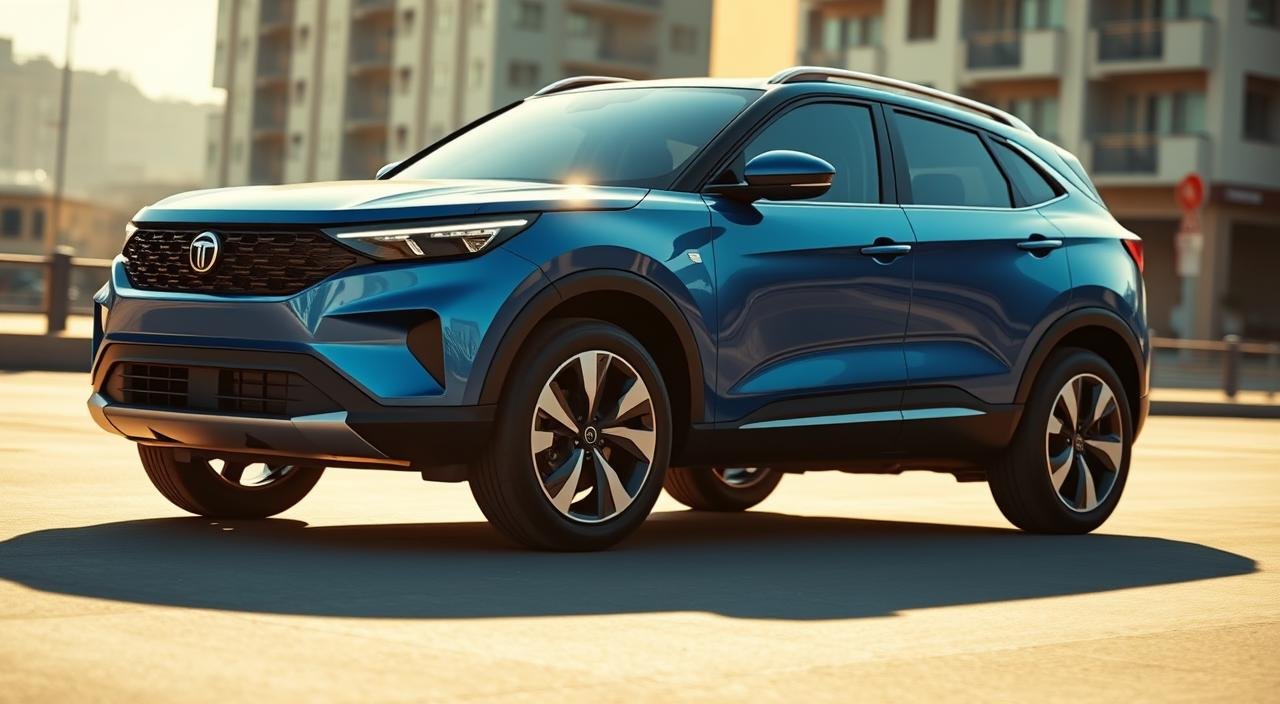
Jun
Are you ready to see the future of green cars in India? Tata Motors has unveiled the Tata Harrier EV, a game-changing electric SUV. It’s set to change the Indian car market with its advanced tech and strong performance. Let’s dive into 10 amazing images that show off the Harrier EV’s design and features.
The Tata Harrier EV starts at Rs 21.49 lakh, making it a great choice for those who care about the planet. It has two battery packs and can go up to 627 km on a single charge. You can choose from three variants and four colors, including a special Stealth Black for the Stealth Edition.
Key Takeaways:
- The Tata Harrier EV is Tata Motors’ flagship electric SUV, packed with advanced features
- Two battery pack options provide a claimed range of up to 627 km
- Available in three variants and four color options, including an exclusive Stealth Black
- Introductory ex-showroom price of Rs 21.49 lakh makes it an attractive eco-friendly option
- Set to revolutionize the Indian electric vehicle market with cutting-edge technology and performance
Overview of the Tata Harrier EV
The Tata Harrier EV is a game-changing electric vehicle. It combines the latest technology with a sleek design. Built on Tata’s advanced Acti.ev platform, it offers an unmatched driving experience. This SUV shows Tata’s dedication to innovation in electric vehicles.
What Makes the Tata Harrier EV Unique?
The Tata Harrier EV stands out with its unique features. Its design is both familiar and futuristic. It keeps the iconic SUV look but adds modern touches like a sealed-off grille and blue accents.
It also has smart features for better convenience and functionality. These include:
- Vehicle-to-Load (V2L) capability, allowing you to power external devices
- Vehicle-to-Vehicle (V2V) charging for sharing power with other EVs
- Innovative ‘Summon Mode’ for remote parking and retrieval
Key Features and Innovations
The Tata Harrier EV is powered by cutting-edge electric technology. Its high-capacity battery and efficient motors offer great range and performance. Fast charging makes it easy to recharge.
Inside, the Harrier EV is spacious and tech-savvy. The infotainment system and digital cluster make for a smooth experience. Premium materials and design elements make the interior luxurious and comfy.
Exterior Design Highlights
The Tata Harrier EV has a stunning exterior design. It combines bold looks with smooth aerodynamics. The front of this electric SUV grabs your attention with its striking features.
Eye-Catching Front Grille and Headlights
The Harrier EV’s front grille has a unique design with sleek lines. It proudly shows off the Tata logo in the center. The LED headlights, shaped like triangles, add an aggressive look.
Below, a wide air intake with vertical slats looks good and helps cool the vehicle.
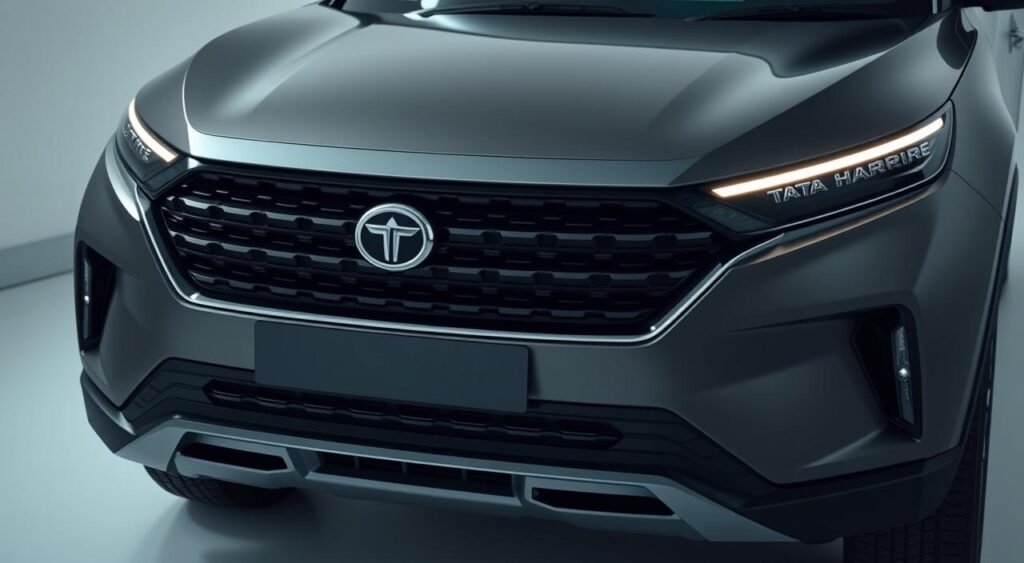
Sleek Body Lines and Stance
From the side, the Harrier EV looks similar to its gas-powered version. Its body lines show strength and athleticism. Black body cladding adds a rugged look and protects against minor damage.
The 19-inch dual-tone alloy wheels make the SUV look even more powerful. Subtle EV badging shows it’s an eco-friendly car.
Color Options and Finishes
Tata offers the Harrier EV in four exciting colors. This lets customers pick a color that matches their style. For a unique look, there’s a special matte Stealth Black edition.
Interior Comfort and Technology
When you enter the Tata Harrier EV, you’ll find a roomy and stylish interior. It features a dual-tone color scheme of white and grey, with premium leatherette seats. The SUV offers power-adjustable and ventilated front seats, a boss mode for the co-passenger, and rear AC vents for the best climate control.
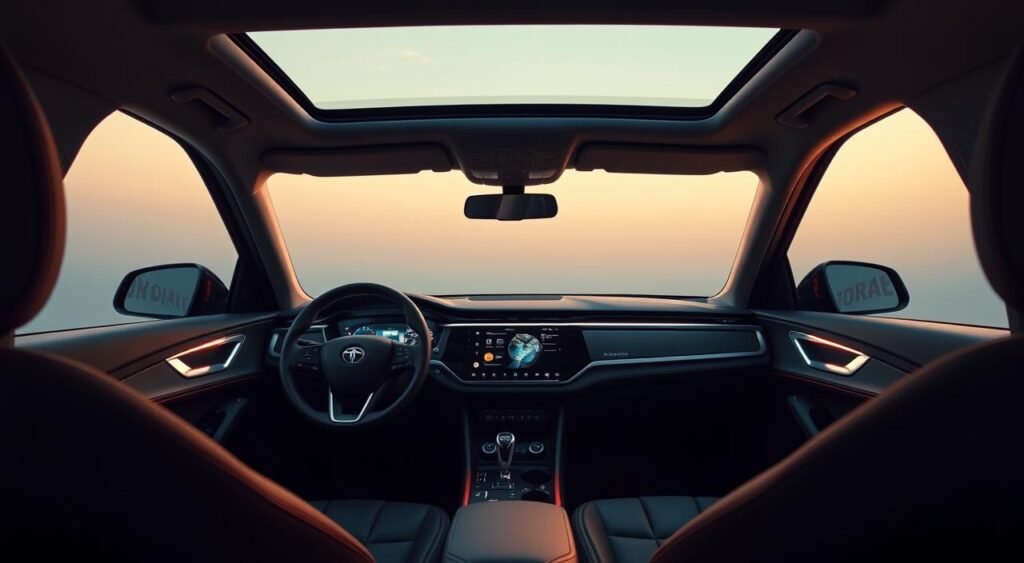
Spacious Cabin Layout
The Tata Harrier EV’s interior is designed for comfort and space. It has plenty of legroom and headroom for everyone, making long trips comfortable. The seats are ergonomically designed and adjustable, adding to the comfort.
Infotainment System Features
The heart of the Tata Harrier EV’s tech is its 14.5-inch QLED touchscreen. It controls navigation, media, and vehicle settings. The system also includes a 10.25-inch digital driver’s display for quick info access. You’ll find dual-zone climate control and a 10-speaker JBL audio system for great sound.
Safety Features Available
The Tata Harrier EV focuses on safety with many advanced features. It has seven airbags for protection in accidents. A 360-degree camera system makes parking easier. It also has blind spot monitoring, ESC, TPMS, and Level 2 ADAS for safer driving.
Performance Specifications
The Tata Harrier EV offers top-notch performance thanks to its advanced electric powertrain. It comes with two battery pack sizes and strong motor setups. This makes for an exciting drive.
Electric Powertrain Overview
The Harrier EV has a 65 kWh or 75 kWh battery pack. The rear-wheel drive version has 238 PS. The all-wheel drive version has 390 PS and 504 Nm of torque.
When Boost Mode is on, the AWD Harrier EV goes from 0 to 100 kmph in 6.3 seconds. This gives a thrilling boost of power.
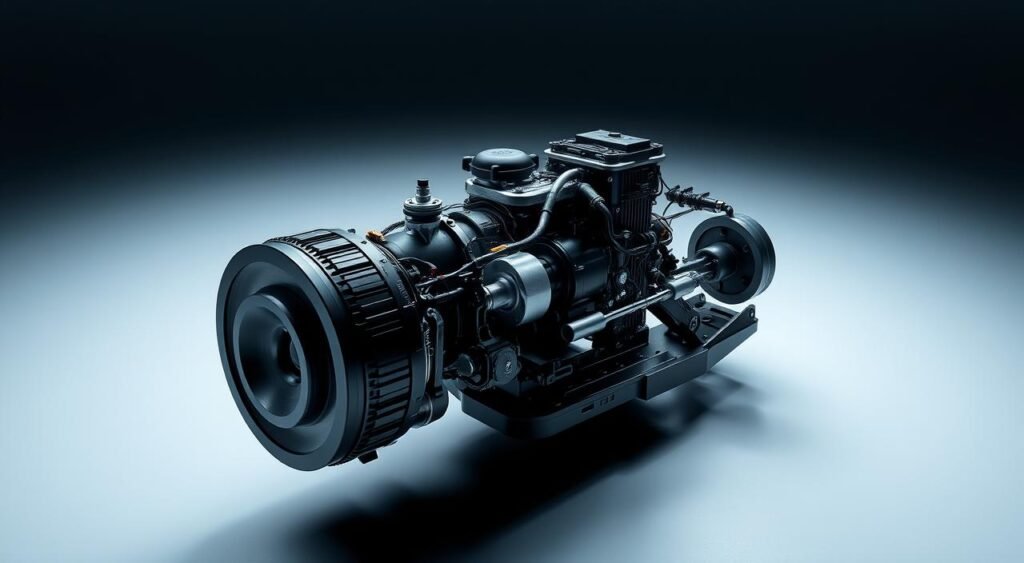
Range and Charge Time
The 75 kWh battery pack gives the Harrier EV a range of up to 627 km. This means you can go on long trips without needing to charge often. It supports both AC and DC fast charging.
| Charging Type | Charging Power | Charging Speed |
|---|---|---|
| AC Charging | 3.3 kW / 7.2 kW | 8-10 hours (0-100%) |
| DC Fast Charging | 120 kW | 25 minutes (20-80%) 15 minutes (up to 250 km range) |
Driving Experience and Handling
The Tata Harrier EV offers a smooth drive with instant torque. Its low center of gravity makes it stable and easy to handle. The regenerative braking system also boosts energy efficiency and allows for single-pedal driving.
With its strong performance, long range, and quick charging, the Tata Harrier EV is a top choice. It offers an exciting and eco-friendly driving experience.
Sustainability Initiatives
The Tata Harrier EV is a big step for Tata Motors in going green. It’s an electric car that helps cut down on carbon emissions. It shows Tata Motors’ dedication to making eco-friendly cars.
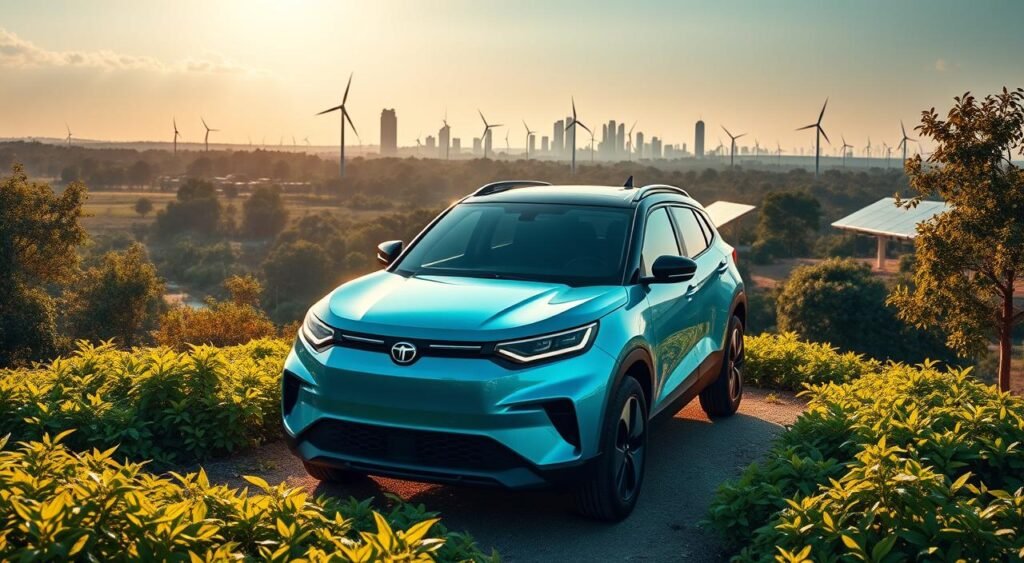
The Harrier EV uses materials that are good for the planet. Tata Motors picked these materials to be both green and strong. They use recycled and sustainable stuff to cut down on waste and save resources.
Eco-Friendly Materials Used
The Tata Harrier EV has many green materials inside and out. These include:
- Recycled plastics in the dashboard, door panels, and trim
- Sustainable fabric upholstery from recycled stuff
- Bio-based plastics from plant oils
- Lightweight aluminum and steel to make it more efficient
Tata’s Commitment to Green Energy
Tata Motors goes beyond just using green materials. They also focus on green energy for the Harrier EV’s whole life. This includes:
| Initiative | Description |
|---|---|
| Renewable Energy | Tata Motors is putting money into solar and wind power. They want to use less fossil fuel in making cars. |
| Charging Infrastructure | Tata is growing the number of EV charging stations in India. This makes it easier for Harrier EV owners to charge up with green energy. |
| Recycling Programs | Tata Motors has recycling plans for old car parts and batteries. This helps reduce waste and protect the environment. |
Tata Motors is making the Harrier EV a green choice for those who care about the planet. It’s a car that’s good for the environment without losing out on performance or looks.
Comparisons with Competitors
The Tata Harrier EV is set to shake up the electric SUV market. But how does it stack up against its rivals? Let’s dive into the Tata Harrier EV comparison with the Mahindra XEV 9e and the BYD Atto 3.
How the Harrier EV Stacks Up Against Rivals
The Tata Harrier EV shines with its impressive range and quick charging. The Mahindra XEV 9e has similar features. But the BYD Atto 3 leads with its longer range and faster charging.
Yet, the Harrier EV’s sleek design and roomy interior give it a comfort and style edge.
| Feature | Tata Harrier EV | Mahindra XEV 9e | BYD Atto 3 |
|---|---|---|---|
| Range (km) | 400 | 380 | 420 |
| Fast Charging Time (0-80%) | 60 min | 70 min | 50 min |
| Battery Capacity (kWh) | 60 | 55 | 60 |
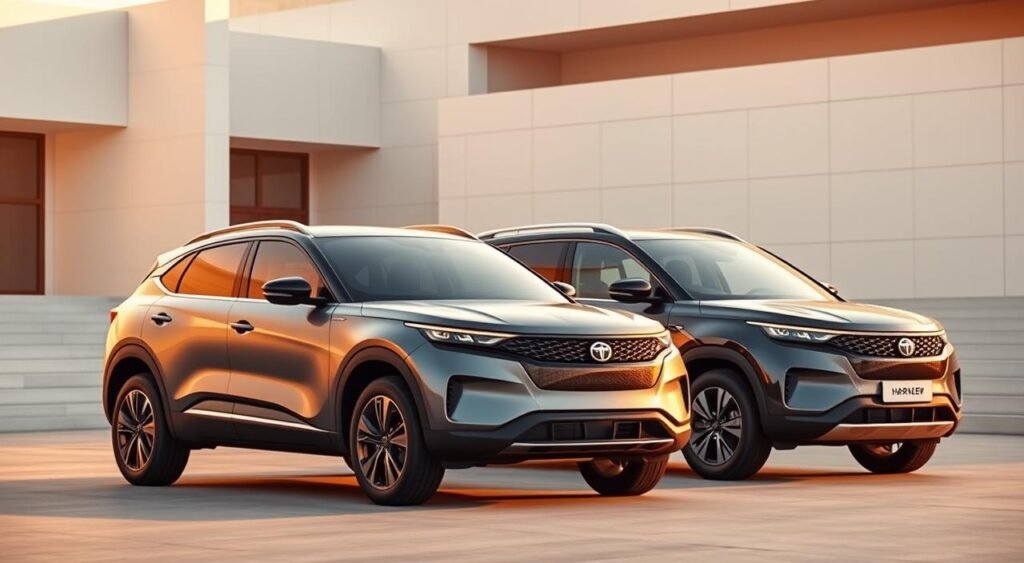
Pricing Comparison Overview
The Tata Harrier EV’s pricing is yet to be fully revealed. But it starts at Rs 21.49 lakh (ex-showroom). This makes it a competitive choice against the Mahindra XEV 9e and the BYD Atto 3.
Bookings for the Harrier EV open on July 2, 2025. This gives interested buyers a chance to be among the first to try this advanced electric SUV.
While we wait for more details, it’s clear the Tata Harrier EV is set to make a big splash. With its mix of performance, style, and price, it’s definitely worth watching for those looking at electric SUVs.
User Testimonials and Reviews
The Tata Harrier EV is making waves, with both early users and car experts sharing their thoughts. Their feedback and reviews give us a peek into what this electric SUV is like. They talk about its performance, features, and value.
Real User Experiences
Harrier EV owners love its range, design, and tech. They say it’s roomy and comfy inside, and easy to drive. People also appreciate how it handles different roads well, thanks to its suspension and electric power.
Expert Opinions on the Harrier EV
Car experts see the Tata Harrier EV as a big deal in electric SUVs. They say it’s a great mix of style, performance, and price. They like its long range, quick charging, and smart features, making it a top pick for eco-friendly buyers.
FAQ
What is the starting price of the Tata Harrier EV?
The Tata Harrier EV starts at Rs 21.49 lakh, ex-showroom.
What is the claimed range of the Tata Harrier EV?
It has two battery packs. The range is up to 627 km (MIDC).
How many variants and color options are available for the Harrier EV?
There are three variants and four colors. Plus, a special Stealth Edition in Stealth Black.
What smart features does the Harrier EV offer?
It has V2L, V2V charging, and a ‘Summon Mode’ for remote movement.
What are the interior features of the Harrier EV?
Inside, you’ll find a dual-tone cabin with leatherette seats. It has power-adjustable and ventilated front seats. There’s also a boss mode for the co-passenger seat and rear AC vents.
It comes with a 14.5-inch QLED screen, a 10.25-inch digital display, and dual-zone auto AC. Plus, a 10-speaker JBL audio system.
What are the performance specifications of the Harrier EV?
It comes with 65 kWh and 75 kWh batteries. The RWD version has 238 PS. The AWD version has up to 390 PS and 504 Nm.
It goes from 0-100 kmph in 6.3 seconds with Boost Mode. It supports 3.3 kW and 7.2 kW AC charging, and 120 kW DC fast charging.
How does the Harrier EV contribute to Tata Motors’ sustainability initiatives?
As an electric vehicle, it supports Tata’s goal to reduce environmental impact. It uses eco-friendly materials, showing Tata’s commitment to green energy.
What are the Harrier EV’s main competitors?
Its main rival is the Mahindra XEV 9e. The BYD Atto 3 is also a competitor.
When will bookings for the Harrier EV open?
Bookings start on July 2, 2025.
What are the initial user reviews and expert opinions on the Harrier EV?
Users love it for being an excellent electric car with great features at a good price. Experts praise its design, range, and smart features. They see it as a top choice in electric SUVs.

May
Are you ready for a leap into the future of electric mobility in India? Stellantis, the global automotive giant, has just announced an exciting partnership. Leapmotor, a rising star among Chinese electric vehicle brands, is set to make its debut on Indian roads. They promise affordable and innovative EVs for the masses.
This bold move by Stellantis aims to tap into the growing demand for electric vehicles in India. Consumers are looking for eco-friendly and cost-effective transportation options. With Leapmotor’s cutting-edge technology and Stellantis’ extensive experience, this collaboration has the power to disrupt the market. It could also speed up the adoption of EVs across the country.
Key Takeaways:
- Stellantis partners with Chinese EV startup Leapmotor to enter the Indian market
- Leapmotor to be Stellantis’ fourth brand in India, joining Citroen, Jeep, and Maserati
- Initial plans involve assembly of CKD kits, with increased localization in the future
- Partnership aims to bring affordable and innovative electric vehicles to Indian consumers
- Move expected to accelerate EV adoption and transform the Indian automotive landscape
Overview of Leapmotor and Its EV Offerings
Leapmotor is a Chinese electric vehicle maker started in 2015. It’s known for its innovative and stylish cars. The company is based in Hangzhou and aims to provide quality, green cars worldwide.
Introduction to Leapmotor
Leapmotor has always focused on electric cars. It combines the latest tech, sleek designs, and eco-friendliness. This has made it a big name in China’s EV market.

Key Features of Leapmotor EVs
Leapmotor has three EV models for different needs:
- T03 hatchback: A small city car with a 37.3 kWh battery, 94 bhp power, and up to 395 km range.
- B10 compact SUV: A stylish SUV for urban families.
- C10 SUV: The top model, available in two versions:
- BEV with a 69.9 kWh battery and 424 km range.
- REEV with a 28.4 kWh battery and a 1.5l petrol generator, for over 950 km range.
| Model | Type | Battery | Range |
|---|---|---|---|
| T03 | Hatchback | 37.3 kWh | 395 km (WLTP Urban) |
| C10 (BEV) | SUV | 69.9 kWh | 424 km |
| C10 (REEV) | SUV | 28.4 kWh + 1.5l petrol generator | 950+ km |
Leapmotor’s Vision for Sustainable Mobility
Leapmotor wants to make transportation greener. It focuses on electric cars and improving battery tech. This helps make the car industry more eco-friendly.
With models like the T03, C10 SUV, and B10 compact SUV, Leapmotor meets the demand for green cars. It’s ready to serve India and more.
Stellantis and Its Role in the Indian EV Market
Stellantis is a leading global car group aiming big in India’s electric vehicle (EV) market. It has brands like Citroen, Jeep, and Maserati. Stellantis India wants to tap into the growing demand for EVs.

The company sees huge growth in India and plans to bring top EV tech. It will meet the changing needs of Indian buyers. Stellantis is ready to play a big role in India’s electric future.
Background on Stellantis
Stellantis was created in 2021 by merging Fiat Chrysler Automobiles (FCA) and Groupe PSA. This merger united many car brands:
- Citroen
- Jeep
- Maserati
- Peugeot
- Fiat
- Chrysler
Stellantis now spans over 130 countries and employs over 400,000 people. It’s well-equipped to lead in EV innovation.
Strategic Goals for Electric Vehicles in India
Stellantis India has big plans for EVs. It wants to:
| Objective | Target Timeline |
|---|---|
| Launch a range of affordable EVs | 2023-2025 |
| Establish a robust charging infrastructure | 2024-2026 |
| Achieve a 30% EV sales mix | By 2030 |
To hit these goals, Stellantis India is investing in R&D and partnerships. It’s working with tech leaders and suppliers to create top EV platforms and components for India.
Stellantis India plans to offer electric cars from Citroen, Jeep, and Maserati. It aims to attract different customers and boost EV adoption in India.
Market Potential for Leapmotor EVs in India
The electric vehicle market in India is growing fast. People are looking for EVs in many different types. Leapmotor is getting ready to join this market. It’s important to know who they’re up against, what people want, and what’s making EVs popular.
Growing Demand for Electric Vehicles
More and more people in India want electric cars. This is because of high fuel prices, wanting to help the environment, and government support. The goal is to have 30% of cars electric by 2030. This is a big chance for Leapmotor to make a mark in India.
Competitive Landscape in the EV Segment
Leapmotor will compete with big names in the Indian EV market. These include:
- Tata Motors
- Mahindra Electric
- Hyundai
- MG Motor
- Upcoming brands like BYD
To be different, Leapmotor needs to offer something new, be priced right, and have a strong brand.
Consumer Trends Favoring EV Adoption
There are trends that are making people choose electric cars in India:
| Trend | Impact on EV Adoption |
|---|---|
| Rising fuel costs | People want cheaper ways to get around |
| Environmental awareness | More people want to help the planet by choosing EVs |
| Government incentives | Subsidies and tax breaks are making EVs more attractive |
| Improving EV technology | Better batteries and charging options are making EVs more practical |
By matching what people want, Leapmotor can take advantage of the growing EV market in India.
Import and Regulatory Considerations for Leapmotor
Leapmotor is getting ready to enter the Indian market. They must deal with import and regulatory issues. The rules and tariffs for electric vehicles in India will affect how Leapmotor brings its cars to the market.
Import Tariffs and Its Impact
Import duties on electric vehicles in India can change how much Leapmotor charges for its cars. The duties are as follows:
| Vehicle Type | Import Duty |
|---|---|
| Fully Built Units (FBUs) | 60% |
| Completely Knocked Down (CKD) Units | 15% |
| Semi Knocked Down (SKD) Units | 30% |
To lower costs, Leapmotor might start by importing CKD units. They will assemble these at Stellantis’ factory in Ranjangaon. This plan helps keep prices down and allows for local production later.
Compliance with Indian Standards
Leapmotor’s EVs need to meet Indian safety and performance standards. This ensures they are safe, work well, and are good for the environment. Some important standards include:
- AIS-048: Battery safety for electric vehicles
- AIS-049: Electric vehicle type approval
- AIS-138: Electric vehicle charging system
Following these standards will help Leapmotor smoothly enter the Indian market. It will also gain the trust of consumers.
Government Incentives for EVs
The Indian government has EV incentives under the FAME II scheme. These incentives help make electric vehicles more appealing and support the EV ecosystem in India.

Under FAME II, electric vehicles get various incentives. These include:
- Demand incentives from Rs. 10,000 to Rs. 1.5 lakh, based on the vehicle and battery
- Incentives for setting up charging stations
- Income tax exemption of up to Rs. 1.5 lakh on electric vehicle loans
By using these incentives, Leapmotor can offer better prices. This makes electric vehicles more affordable for Indian buyers, helping to grow the EV market.
Expected Launch Timeline and Models
The Leapmotor India launch is coming soon, and everyone is excited. Leapmotor will bring two new models to the Indian market. These models are expected to make a big splash in their segments.

T03 Hatchback: A Tiago EV Rival
The first model is the T03 hatchback. It’s a stylish, compact electric car. It will compete with the Tata Tiago EV. The T03 offers great range, advanced tech, and a good price.
C10 SUV: Taking on the Creta Electric
Next up is the C10 SUV. It’s a stylish, spacious 5-seater. It will challenge the Hyundai Creta Electric competitor, MG Windsor, and the upcoming Maruti e Vitara. The C10 has the latest tech, premium interiors, and a competitive price.
Stellantis has big plans for Leapmotor in India. They aim to bring six Leapmotor EVs to India by 2027. This will help Leapmotor build a strong presence in the market.
Collaboration and Partnerships
As Leapmotor enters the Indian market, strategic collaborations and partnerships are key. They will help establish a strong presence. Leapmotor will use Stellantis India dealerships to distribute its electric vehicles across the country. This partnership will boost both Leapmotor’s reach and Stellantis dealerships’ sales and revenue.

Using Stellantis India dealerships, Leapmotor saves time and resources. The dealerships’ experience in the Indian market is invaluable. It helps promote and sell Leapmotor’s electric vehicles to Indian consumers.
Local Partnerships for Distribution
Leapmotor will also partner with local distributors and logistics providers. These partnerships ensure smooth delivery of vehicles across India. They help deal with the Indian market’s complexities, like varied regional preferences and infrastructure challenges.
Potential Collaborations with Indian Tech Firms
Leapmotor may team up with Indian tech firms to enhance its offerings. These collaborations could focus on:
- Developing India-specific software and applications for Leapmotor’s EVs
- Integrating local payment and charging solutions
- Enhancing user experience through localized interfaces and features
- Optimizing battery performance for Indian climatic conditions
By partnering with Indian tech firms, Leapmotor can tap into local expertise. This creates a compelling offer for Indian consumers. These collaborations also boost the Indian tech ecosystem in the EV space.
Future Outlook and Expansion Plans
Leapmotor is entering the Indian market with a solid growth plan. It aims to make a big impact in the fast-growing EV segment. Stellantis, Leapmotor’s parent, sees great opportunities in India. They plan to bring a variety of electric vehicles that meet Indian customers’ needs.
Leapmotor will introduce many new EV models soon. These will be available at different prices and in various categories. This strategy will help the brand appeal to a wide range of customers. Leapmotor wants to become a major player in the Indian EV market by constantly innovating and growing its product line.
Impact on the Indian Automotive Industry
Leapmotor’s arrival in India could shake up the auto industry. It will bring advanced EV technology and exciting products. This could make more people choose electric vehicles over traditional ones.
Leapmotor’s presence will also help build a strong EV ecosystem in India. By working with local partners and investing in charging infrastructure, it will support the growth of related industries. This approach will benefit Leapmotor and help make the Indian auto industry greener and more advanced.
FAQ
What is Leapmotor, and what types of EVs does it offer?
Why is Stellantis bringing Leapmotor to the Indian market?
What is the current state of the Indian EV market, and what competition will Leapmotor face?
What regulatory challenges and incentives will Leapmotor face in India?
What models is Leapmotor planning to launch in India, and what is the expected timeline?
How will Leapmotor’s entry impact Stellantis’ existing dealership network in India?
What is Leapmotor’s long-term vision for the Indian market, and how will it impact the automotive industry?

Apr
Get ready for a big change in India’s car world. Mercedes-Benz is bringing the CLA EV to India. This car will mix the CLA’s cool look with the latest electric tech. It’s going to give drivers an exciting ride like never before.
As excitement grows, let’s look at the 5 main points that make the Mercedes-Benz CLA EV a big deal in India’s EV scene.

The Mercedes-Benz CLA EV is going to change the game in India’s luxury electric car market. It will have a sporty look, strong power, and the latest tech. This car is for those who love luxury and care about the planet.
The exact launch date is a secret, but experts think it will arrive by August 2025. This will be a big step for India’s car industry.
Key Takeaways
- Mercedes-Benz confirms launch of CLA EV in India
- Electric vehicle to feature sporty design and powerful performance
- CLA EV targets environmentally conscious luxury car enthusiasts
- Expected launch by August 2025
- Marks significant milestone for India’s growing EV market
Overview of the Mercedes-Benz CLA EV
The Mercedes-Benz CLA EV is set to make waves in the Indian market. It combines style, performance, and sustainability. This electric sedan showcases Mercedes-Benz’s craftsmanship and cutting-edge technology.
What Sets the CLA EV Apart from Other Models?
The Mercedes-Benz CLA EV stands out with its unique features:
- Sleek, coupe-like silhouette that exudes elegance and sophistication
- Powerful electric motor delivering instant torque and smooth acceleration
- Long-range battery capacity for extended drives without range anxiety
- Advanced driver assistance systems ensuring a safe and comfortable ride
Design Features of the CLA EV
The CLA EV boasts a stylish design that turns heads on Indian roads. Its notable design elements include:
| Exterior | Interior |
|---|---|
| Aggressive front bumper with star-themed grille | Futuristic dashboard with MBUX Superscreen |
| Sleek LED headlights and taillights | Premium leather upholstery and trim |
| Aerodynamic body lines for improved efficiency | Ambient lighting with customizable colors |

Target Audience for the CLA EV in India
The Mercedes-Benz CLA EV is for those who value luxury and eco-friendliness. It’s perfect for:
- Luxury car enthusiasts looking to switch to an eco-friendly option
- Tech-savvy individuals who value cutting-edge features and connectivity
- Style-conscious buyers seeking a vehicle that makes a bold statement
- Environmentally conscious consumers looking to reduce their carbon footprint
With its stylish design, premium interior, and Mercedes-Benz CLA EV features, the CLA EV is set to make a big impact in India.
Launch Date and Availability in India
The Mercedes-Benz CLA EV is coming to India, a big step for electric cars here. The Mercedes-Benz CLA EV India Launch Date is not yet confirmed. But, everyone is excited to see it.
Expected Launch Timeline
The CLA EV is expected to hit Indian roads by August 2025. Mercedes-Benz plans to grow its electric car lineup. They want to meet India’s need for green cars.

Pre-Booking Information
People are getting excited about the Mercedes-Benz CLA EV launch. They want to book it early. But, Mercedes-Benz hasn’t shared the pre-booking details yet.
Regions Covered During Launch
Mercedes-Benz wants the CLA EV to be available everywhere in India. They will launch it in big cities and major towns. These include:
- Delhi
- Mumbai
- Bangalore
- Chennai
- Hyderabad
- Pune
- Kolkata
By focusing on these areas, Mercedes-Benz aims to reach more people. They want to sell to those who care about the environment and like new technology.
Specifications and Performance
The Mercedes-Benz CLA EV stands out with its impressive specs and performance. It combines cutting-edge tech and advanced engineering for a thrilling drive. This sleek sedan also supports sustainable mobility.
Battery Capacity and Range
The CLA EV has an 85 kWh battery pack with 800-volt tech. This setup gives it a WLTP range of up to 792 km on one charge. Drivers can go long distances without needing to recharge often.

Motor Power and Performance Figures
The CLA EV comes in two strong variants. The CLA 250+ has 272 PS, and the CLA 350 4MATIC boasts 354 PS. These electric motors offer quick torque and smooth acceleration for an exciting drive.
| Variant | Power (PS) | Drivetrain |
|---|---|---|
| CLA 250+ | 272 | Rear-wheel drive |
| CLA 350 4MATIC | 354 | All-wheel drive |
Charging Time and Infrastructure Compatibility
The CLA EV can charge up to 320 kW, making it fast. Just 10 minutes of fast charging adds over 300 km of range. It works with both AC and DC charging, making it easy to use.
Innovative Technology and Features
The Mercedes-Benz CLA EV is a leader in electric luxury cars. It has advanced technology that makes driving safer, more connected, and enjoyable for everyone.

The CLA EV’s heart is the MBUX Superscreen. It combines three high-resolution displays. The driver gets a 10.25-inch screen for vehicle info. The 14.6-inch screen for infotainment is huge. Passengers have their own 14-inch screen for a personal experience.
Infotainment Options
The MBUX Superscreen offers a top-notch infotainment experience. It has clear graphics, easy touch controls, and voice commands. You can easily access apps, music, and more. It also supports wireless Apple CarPlay and Android Auto for easy smartphone connection.
Safety Features and Driver Assistance
Safety is a top priority in the Mercedes-Benz CLA EV. Its Advanced Driver Assistance System (ADAS) keeps you and your passengers safe. Key safety features include:
- Adaptive Cruise Control with Stop & Go
- Active Brake Assist with pedestrian detection
- Blind Spot Assist
- Lane Keeping Assist
- Parking Assist with 360-degree camera
These systems watch your surroundings, warn you of dangers, and can even help avoid accidents.
Connectivity and Smart Features
The Mercedes-Benz CLA EV offers smart connectivity features. It has a built-in Wi-Fi hotspot for staying online. The Mercedes me connect app lets you control your CLA EV remotely. You can check the battery, pre-condition the cabin, find your car, and schedule charging.
These features make owning a CLA EV convenient and efficient.
Design and Aesthetics
The Mercedes-Benz CLA EV has a stunning design. It combines aerodynamic efficiency with the brand’s classic style. The exterior styling of the CLA EV shows the latest in Mercedes-Benz’s design, catching the eye with its sleek lines and modern look.

Sleek Exterior Elements
The CLA EV has a streamlined shape that improves its range and performance. Its front is marked by a bold grille with the Mercedes-Benz tri-star logo. The sleek LED headlights provide great light.
The sculpted hood and dynamic side profile make it look sporty and sophisticated.
Spacious and Comfortable Interior
Inside the Mercedes-Benz CLA EV, you’ll find a luxurious and roomy interior. Despite its small size, it feels big. The cabin is made with premium materials and careful craftsmanship.
Highlights include:
- Panoramic all-glass roof that lets in lots of natural light
- Flat floor design for more legroom in the back
- Ample storage solutions throughout the interior
- Ambient lighting that makes the atmosphere calm
Personalization Options
Mercedes-Benz knows everyone has their own style. That’s why the CLA EV offers many customization options. You can choose from different exterior colors and interior upholstery.
These options let you make your CLA EV truly yours. It can reflect your personal style perfectly.
Market Positioning and Pricing Strategy
The Mercedes-Benz CLA EV is set to make a big impact in India’s electric vehicle market. It has a strategic price and a premium feel. It’s designed for those who want luxury, performance, and eco-friendliness all in one.
Mercedes-Benz has positioned the CLA EV to appeal to a specific group. They want to attract buyers who value style, sophistication, and the latest tech. With its strong brand and advanced features, Mercedes-Benz is confident it will grab a big share of the EV market in India.
Expected Price Range
The Mercedes-Benz CLA EV is expected to cost between ₹65-75 lakh (ex-showroom). This price reflects its premium features, advanced tech, and Mercedes-Benz’s reputation for quality. Even though it might be pricier than some rivals, Mercedes-Benz believes it’s worth it for those who want the best.
Comparison with Competitors
The CLA EV will compete with the Kia EV6, BMW iX1, and Hyundai Ioniq 5 in the premium EV segment. But it stands out with its unique style, performance, and luxury. Here’s a comparison table to show the differences:
| Vehicle | Price Range (ex-showroom) | Battery Capacity | Range (WLTP) |
|---|---|---|---|
| Mercedes-Benz CLA EV | ₹65-75 lakh | TBA | TBA |
| Kia EV6 | ₹60-65 lakh | 77.4 kWh | 528 km |
| BMW iX1 | ₹60-70 lakh | 64.7 kWh | 438 km |
| Hyundai Ioniq 5 | ₹45-50 lakh | 72.6 kWh | 481 km |
Value Proposition for Indian Consumers
The Mercedes-Benz CLA EV offers a great value for Indian buyers. It combines luxury, performance, and sustainability perfectly. Its sleek design, advanced features, and zero emissions make it appealing to those who care about the environment and enjoy driving.
Mercedes-Benz also has a wide network of dealerships and service centers in India. This ensures a smooth ownership experience for CLA EV owners. The brand’s focus on customer satisfaction and after-sales support adds to the value, giving buyers peace of mind and unmatched luxury.
Sustainability and Environmental Impact
Mercedes-Benz is a global leader in the car industry. It’s committed to making cars better for the planet. The CLA EV in India shows its effort to make cars more eco-friendly and push for electric vehicles.
EV Initiatives by Mercedes-Benz
Mercedes-Benz is leading the electric car charge. It’s investing in top-notch electric car tech. The company offers many electric models, from small cars to luxury SUVs.
This move helps meet different customer needs. It also encourages people to choose greener transport.
Eco-Friendly Manufacturing Practices
Mercedes-Benz is also making its factories more eco-friendly. It’s using clean energy, cutting down on waste, and recycling materials. The company is also saving water and teaching others to do the same.
These steps show Mercedes-Benz’s dedication to the environment. It’s setting a good example for the car industry.
Importance of EV Adoption in India
The CLA EV’s launch in India is timely. The country is facing pollution problems and needs cleaner cars. Electric vehicles can help reduce pollution and improve air quality.
Mercedes-Benz, as a luxury brand, can inspire others. It can help India move towards cleaner, greener cars faster.
Customer Experience and Support
Mercedes-Benz is known for its top-notch customer support. The CLA EV in India will follow this tradition. They aim to give customers a smooth ownership experience, with the best service and support.
Mercedes-Benz will offer detailed service packages for electric vehicle owners. These packages will include regular maintenance, software updates, and repairs. This will give customers confidence and peace of mind.
Service Packages Offered
Mercedes-Benz has a variety of service packages for CLA EV owners. These include:
- Basic maintenance package covering routine servicing and inspections
- Extended warranty options for long-term protection
- 24/7 roadside assistance for emergency situations
- Dedicated EV technician support for specialized assistance
Warranty and Maintenance Information
The Mercedes-Benz CLA EV comes with a full warranty. This warranty is designed to make customers confident and satisfied. Key points of the warranty are:
- 8-year/160,000 km battery warranty
- 3-year/unlimited km overall vehicle warranty
- Complimentary maintenance for the first 2 years/30,000 km
Mercedes-Benz will give detailed maintenance schedules to CLA EV owners. This ensures their vehicles stay in top shape. Their extensive network of service centers in India is ready for EV maintenance and repairs. They have trained technicians and modern facilities.
Future of Mercedes-Benz in India
Mercedes-Benz India is set for a thrilling future with the launch of the CLA EV. The company is focused on sustainable mobility, planning to introduce many EV models for Indian customers. They aim to grow by bringing innovative, eco-friendly vehicles that are both luxurious and technologically advanced.
Upcoming EV Models on the Horizon
After the CLA EV’s success, Mercedes-Benz India is ready to launch more electric vehicles. These will range from compact cars to luxury SUVs. Mercedes-Benz wants to attract more customers and lead the Indian electric vehicle market with its diverse EV lineup.
Commitment to Sustainable Mobility Solutions
Mercedes-Benz is committed to sustainable mobility globally, including in India. They plan to cut carbon emissions, use eco-friendly manufacturing, and invest in better battery tech. This focus on sustainability will help India’s green mobility movement and ensure a cleaner future.
Expansion Plans in the Indian Market
Mercedes-Benz India plans to grow by expanding its reach across the country. They aim to increase their dealership network, set up more charging stations, and work with local partners. This strategy is to meet Indian customers’ needs, offer top-notch products, and drive sustainable mobility forward.
FAQ
What sets the Mercedes-Benz CLA EV apart from other electric vehicles in India?
The Mercedes-Benz CLA EV is unique with its sporty design and strong performance. It has advanced tech like the MBUX Superscreen and AI. Its sleek look and aggressive style appeal to those who love luxury and want an eco-friendly car.
When is the Mercedes-Benz CLA EV expected to launch in India?
Mercedes-Benz hasn’t shared the exact launch date yet. But, they say the CLA EV will hit Indian roads by August 2025. Details for pre-booking are yet to be announced.
What is the battery capacity and range of the Mercedes-Benz CLA EV?
The CLA EV has an 85 kWh battery pack with 800-volt tech. It can go up to 792 km on a single charge. It can charge up to 320 kW, giving you 300+ km in just 10 minutes.
What innovative features and technology does the Mercedes-Benz CLA EV offer?
The CLA EV boasts advanced features like the MBUX Superscreen. It has a 10.25-inch driver display and a 14.6-inch infotainment screen. It also has a 14-inch passenger screen, multi-zone climate control, and more.
What is the expected price range of the Mercedes-Benz CLA EV in India?
The CLA EV is expected to cost around ₹65-75 lakh (ex-showroom). It will be in the premium electric vehicle segment. It will compete with cars like the Kia EV6 and BMW iX1.
How does the launch of the Mercedes-Benz CLA EV contribute to sustainability and environmental impact in India?
Mercedes-Benz aims to be more sustainable and reduce its environmental impact. The CLA EV is part of their EV plans. Its launch in India shows the importance of EVs in fighting pollution and cutting carbon emissions.
What customer support and service packages can be expected with the Mercedes-Benz CLA EV?
Mercedes-Benz is known for its top-notch customer service. The CLA EV will have great service packages for a smooth ownership experience. Customers will get detailed warranty and maintenance info, ensuring the car’s reliability over time.
